Not sure which type of bread to pick? We are covering 37 types of bread in this comprehensive guide to bread types! From arepa to whole wheat, we’re covering it all, including origins, ingredients, uses, and more!
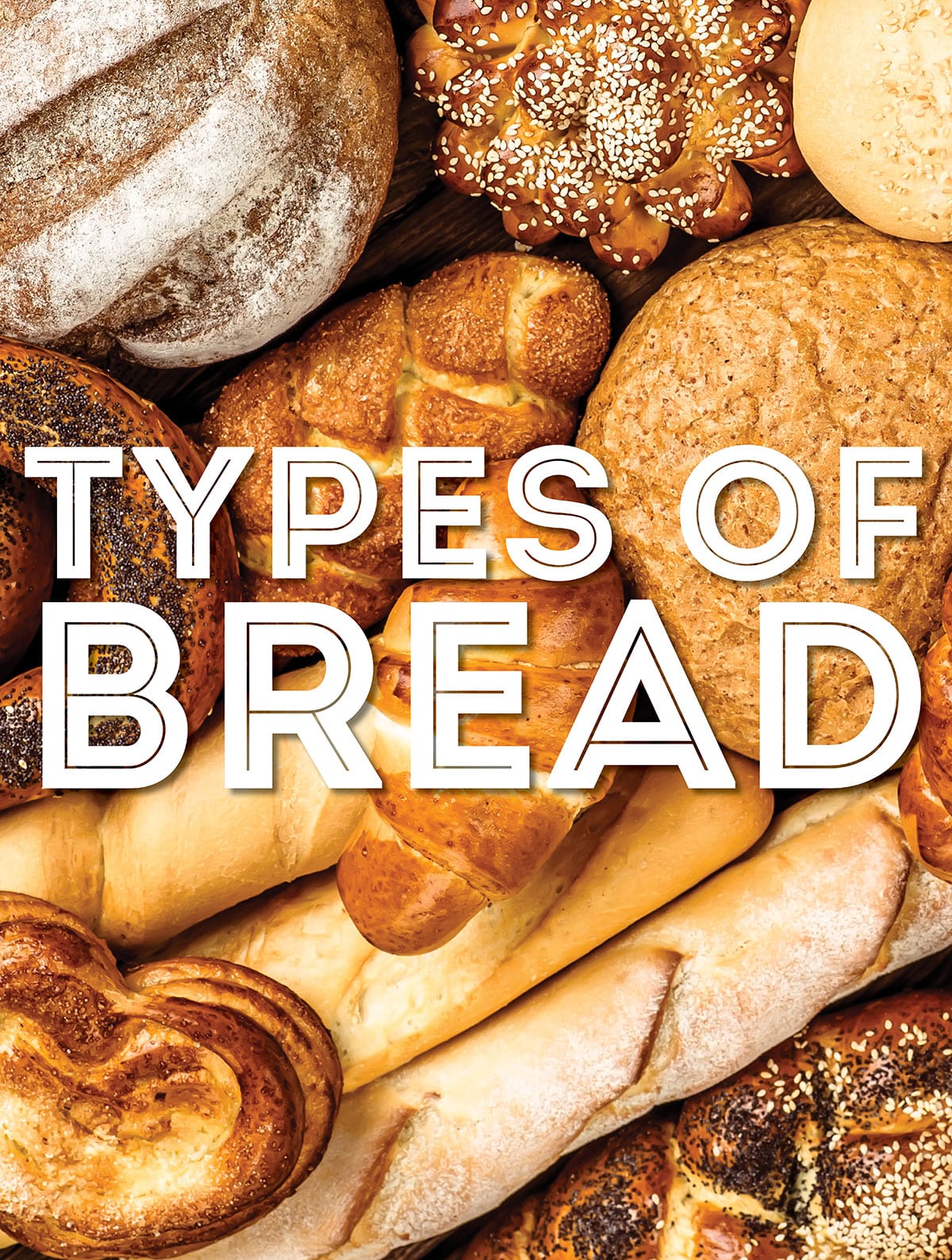
Who doesn’t love bread? It’s the staple of many diets – it’s cheap, versatile, and travels well. Bread is centuries old, so it’s no wonder there are so many varieties of bread!
Some breads are developed on purpose, some by accident, and some out of necessity. Some breads use yeast to leaven them, like brioche, while others use fermentation to leaven it, like sourdough. Breads vary so much which is why we will cover 37 different types of bread in this post, along with some of my favorite recipes for the bread or using the bread. So, let’s get going so we can get baking!
Bread Trivia!
What type of bread is believed to be the oldest? Scroll to the bottom of this post for the answer!
Different Types of Bread
- Arepa Bread
- Babka Bread
- Bagel
- Baguette (French Bread)
- Banana Bread
- Bao Buns
- Beer Bread
- Biscuits
- Bread Pudding
- Brioche Bread
- Brown Bread
- Ciabatta Bread
- Challah Bread
- Cloud Bread
- Cornbread
- Crumpets
- English Muffin
- Flatbread
- Focaccia Bread
- Gluten-Free Bread
- Hokkaido Bread
- Irish Soda Bread
- Italian Bread
- Monkey Bread
- Multigrain Bread
- Naan Bread
- Paratha Flatbread
- Pita Bread
- Potato Bread
- Pumpernickel Bread
- Quick Bread
- Rye Bread
- Sliced Bread
- Sourdough Bread
- Sprouted Grain Bread
- White Bread
- Whole Wheat Bread
Arepa Bread
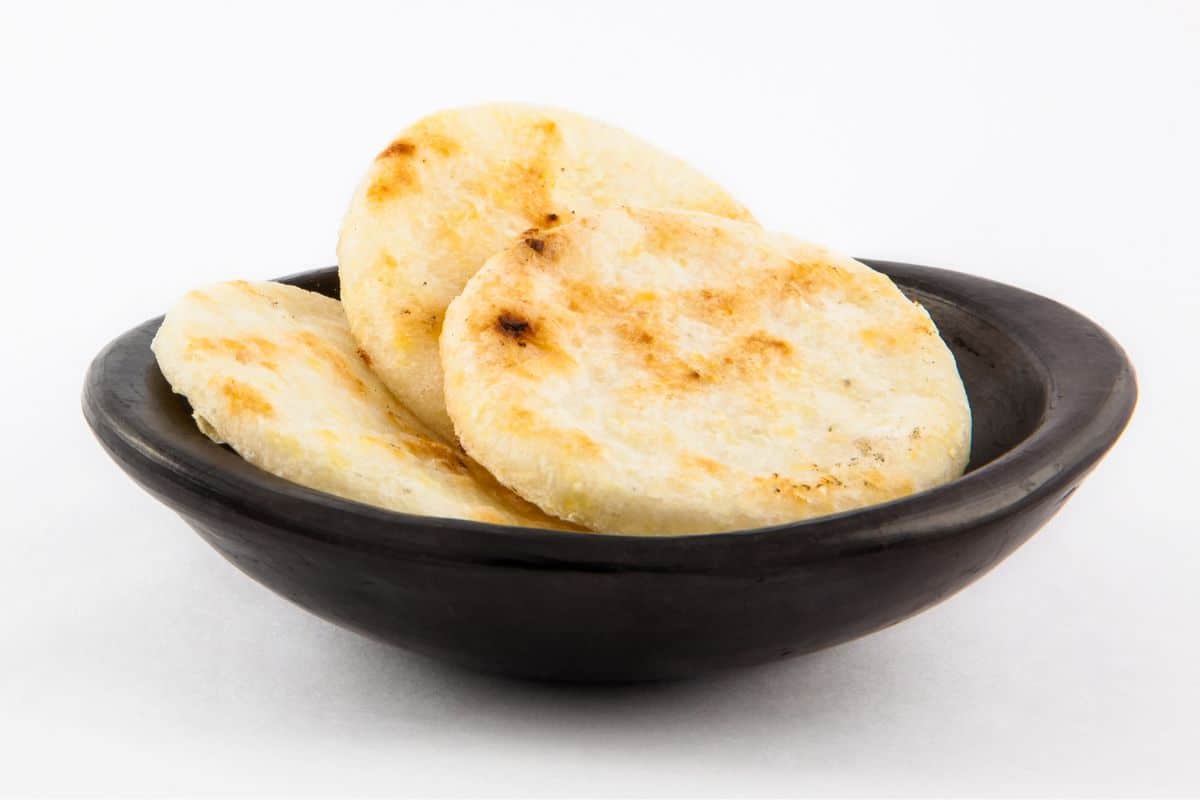
Origin of Arepa: Arepa is a traditional bread in several Latin American countries, with its roots deeply embedded in Venezuelan and Colombian cuisine. It is an old variety dating back to the indigenous peoples of South America long before the arrival of Europeans. Essentially, an arepa is a round, flatbread made from maize dough or cornmeal.
Arepa Bread Ingredients: The core ingredients for making arepas are pre-cooked maize flour, water, and salt. To prepare arepas, one mixes these ingredients into a dough, which is then shaped into rounds and cooked on a griddle or grilling surface until they develop a crispy outer crust and a soft, doughy interior. Some variations may include adding cheese or other fillings into the dough mixture before cooking.
How to Eat Arepa: Arepa can be eaten in various ways. It can be sliced open and stuffed with a variety of fillings, such as cheese, meat, beans, avocado, or eggs. Alternatively, arepas can be served on the side of a meal, acting as a tasty accompaniment to stews, soups, or grilled meats. Eating an arepa is often a messy but delicious experience, as fillings tend to ooze out from the sides. In Venezuela, the arepa is considered a national dish, and there are countless regional variations and fillings to explore.
Babka Bread
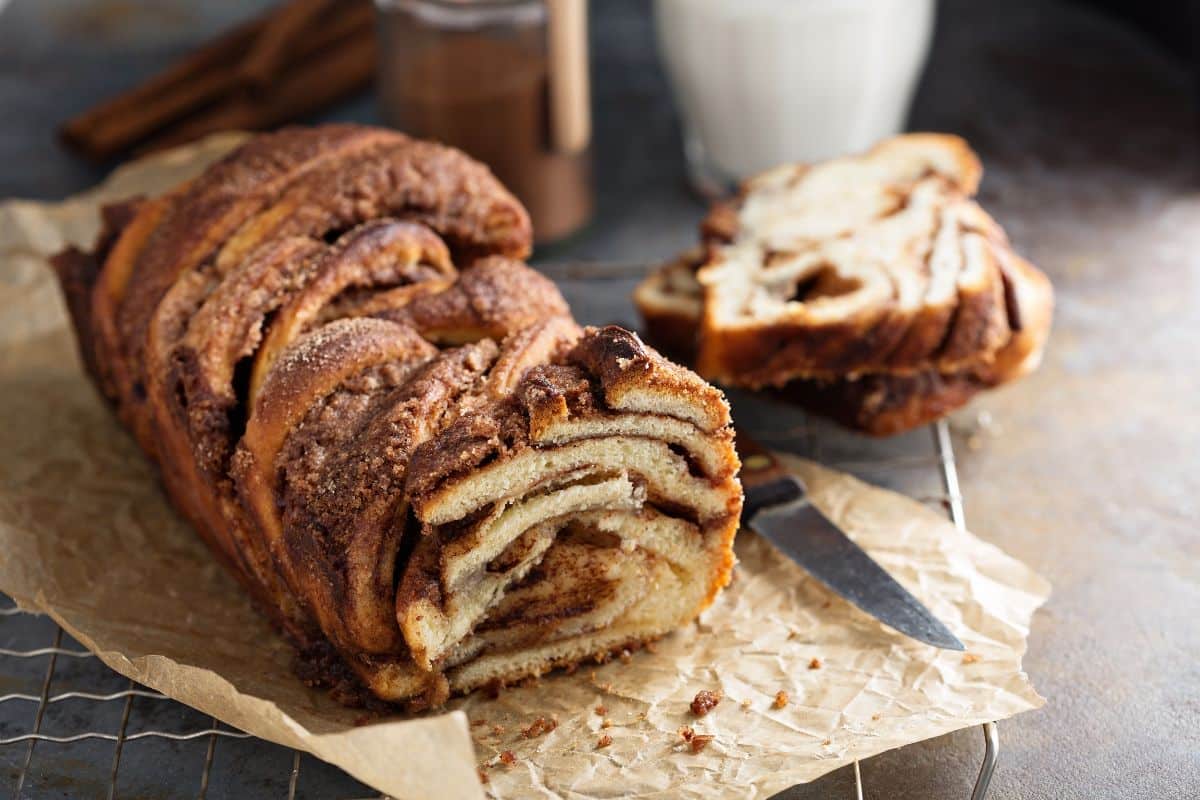
Origin of Babka: Babka is a sweet, braided bread from Eastern Europe, particularly Poland and Ukraine. It is renowned for its rich, twisted appearance and delicious taste. Babka is typically associated with Jewish cuisine and is a popular treat during holidays and special occasions. The word “babka” is derived from the Polish word “baba,” which means “grandmother.” It’s thought that the bread’s twisted appearance resembles a grandmother’s skirt, hence the name.
Babka Bread Ingredients: The key ingredients for making babka include flour, sugar, eggs, butter, and yeast. The dough is prepared by combining these ingredients, resulting in a soft, elastic dough. After allowing the dough to rise, it is rolled out, spread with sweet fillings like chocolate, cinnamon, or nuts, and then rolled up into a log. This log is often twisted or braided before baking.
How to Eat Babka: Babka is typically eaten as a dessert or special treat, and can be sliced into thick pieces and served with coffee or tea. The layers of sweet filling create a delightful contrast with the soft, fluffy bread, making it a favorite among those with a sweet tooth. Babka has gained popularity in many parts of the world, especially in North America, where it’s often found in Jewish bakeries and gourmet food stores. In the Jewish tradition, chocolate babka is quite famous, while in Eastern Europe, you may encounter babka filled with poppy seeds or fruit preserves.
Bagel
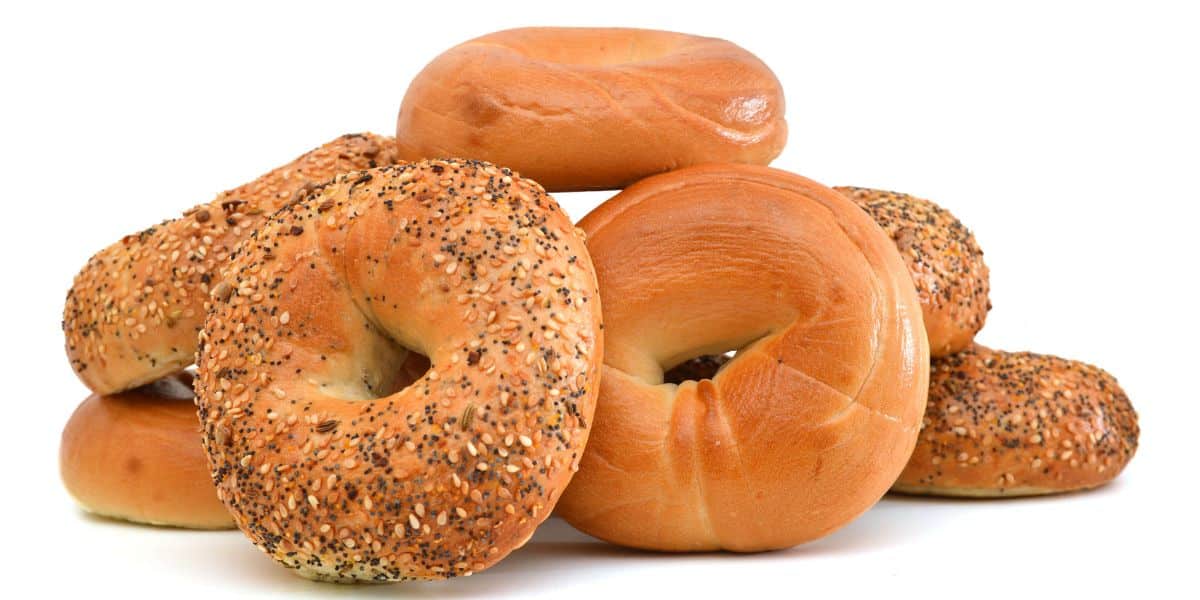
Origin of the Bagel: The bagel originated in Jewish communities in Poland in the 17th century. Its distinctive shape, a ring with a dense, chewy interior and shiny, golden-brown crust, has made it popular worldwide. The “hole” in the bagel is more than just an aesthetic choice. Legend has it that bagels were originally created with a hole in the center so that they could be easily threaded onto a stick for convenient transportation and storage.
Bagel Ingredients: Bagels are made from a relatively simple list of ingredients: high-gluten flour, water, yeast, salt, and a touch of malt syrup or sugar. Traditionally, the dough is mixed, allowed to rise, and then shaped into rings. These rings are briefly (30 seconds to 3 minutes) boiled in water with a little malt syrup before being baked to achieve their chewy crust and soft interior. Many commercial bagels are actually cooked in a steam oven that yields a puffier bagel with a thin crust.
How to Eat Bagels: Bagels are often sliced horizontally and toasted before being spread with cream cheese, butter, or various spreads. In North America, they are a popular breakfast item and are frequently paired with smoked salmon, capers, and onions in a classic dish known as a “bagel with lox” (or in our case, “Vegan Bagel With Lox!”) Bagels can also be used as a base for sandwiches, with various fillings like deli meats, cheese, and vegetables.
Baguette (French Bread)
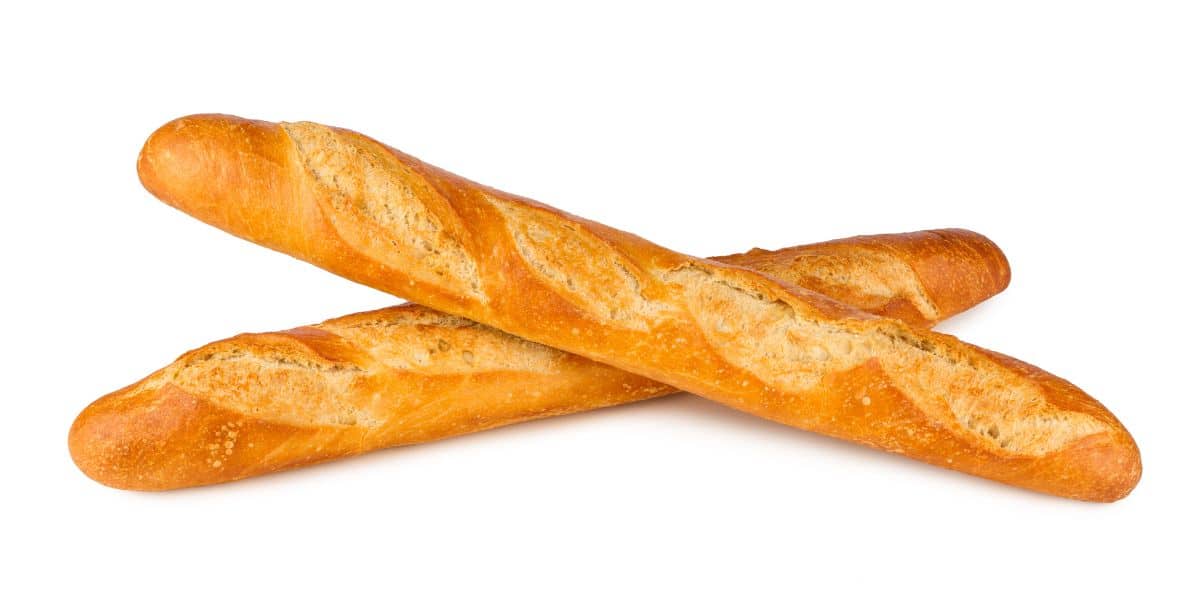
Origin of the Baguette: The baguette, an iconic French bread, has its roots in the early 19th century. It was created in Paris as a response to the growing demand for a lighter, more airy bread. The word “baguette” itself means “stick” or “wand” in French, referring to its long and slender shape. It was designed to be easily carried by city-dwellers. This bread is characterized by its crisp, golden crust and soft, chewy interior.
Baguette Ingredients: Baguettes are made from four simple ingredients: flour, water, yeast, and salt. The dough is mixed, kneaded, and allowed to ferment for several hours to develop its flavor. Afterward, it’s shaped into long, thin loaves and scored before baking. The key to its distinctive crust is steam in the oven, which gives it that wonderful crispness. The baguette is a symbol of French cuisine, and is protected by law in terms of its ingredients and production methods, ensuring its quality and authenticity. In fact, there are regulations in place that dictate the exact length, weight, and ingredients of a traditional baguette.
How to Eat Baguettes: Baguettes are often sliced and served as an accompaniment to cheese, pâté, or used as the base for sandwiches. They are perfect for creating a classic French sandwich, like the famous “jambon-beurre,” made with ham and butter. Baguettes can also be eaten fresh from the oven with a slather of butter or dipped in olive oil bread dip and balsamic vinegar.
Banana Bread
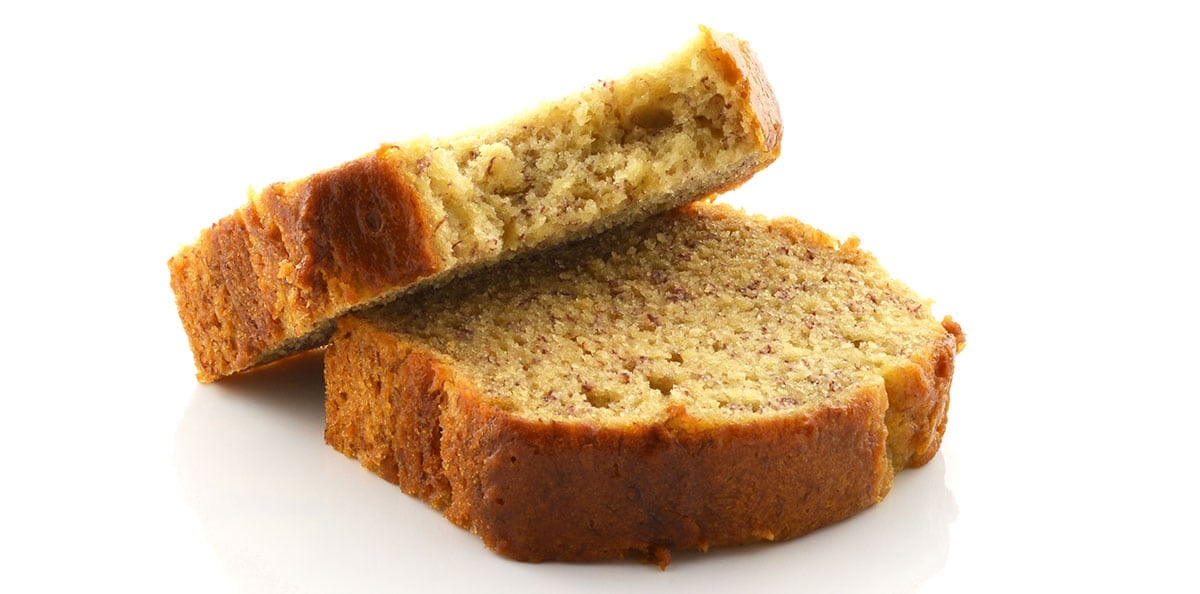
Origin of Banana Bread: Banana bread is a delightful baked treat that originated in the United States during the Great Depression. It was born out of the necessity to use overripe bananas that would otherwise go to waste. This moist, sweet bread is a type of quick bread, meaning it doesn’t require yeast for leavening. Instead, it relies on baking soda or baking powder to rise. Banana bread is known for its distinctive banana flavor and moist, cake-like texture.
Banana Bread Ingredients: The primary ingredients in banana bread include ripe (or over-ripe) bananas, flour, sugar, eggs, and butter or oil. Additional components like vanilla extract, baking soda, and salt are commonly used for flavor and leavening. To make banana bread, you by mashing ripe bananas and then mixing them with sugar, eggs, and melted butter or oil. Flour and leavening agents are added, and the batter is poured into a greased loaf pan. It’s then baked until golden brown and a toothpick inserted into the center comes out clean. You can also make substitutions to get a nice vegan banana bread.
How to Eat Banana Bread: Banana bread is perfect just as it is as a snack or for breakfast, either plain or with a spread of butter or cream cheese. Some people like to add chocolate chips, nuts, or cinnamon to enhance the flavor. It’s also commonly used in desserts like banana bread pudding or as a base for French toast.
Bao Buns
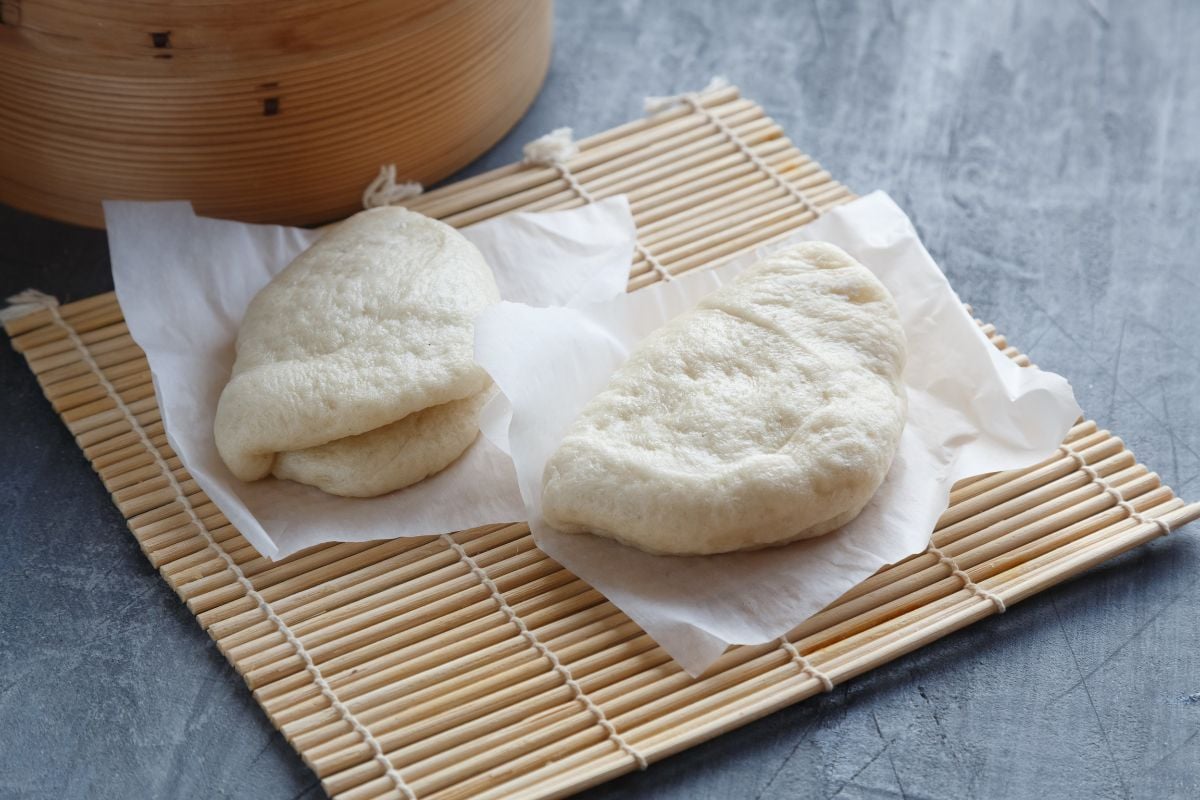
Origin of Bao Buns: They are also known as baozi or simply bao, and are a type of soft, steamed bread originating from China. These fluffy, pillow-like buns are often used as a vessel for various fillings, both savory and sweet. Bao buns are a popular street food and comfort food in many Asian countries.
Bao Bun Ingredients: The primary ingredients in bao buns include flour (rice or wheat), yeast, sugar, and water. The dough is made by mixing these ingredients and allowing the yeast to ferment, causing the dough to rise. After rising, the dough is divided into small portions, rolled into balls, and then flattened into circles. These circles are filled with various fillings, like pork, chicken, vegetables, or sweet ingredients. Finally, the buns are steamed until they become soft and slightly translucent.
How to Eat Bao Buns: They can be eaten as a snack, appetizer, or part of a larger meal. Savory bao buns are often served with a dipping sauce or condiments, while sweet bao buns are more often a dessert. In Chinese culture, bao buns are often associated with family and togetherness, making them a popular choice during festivals and celebrations. The popularity of bao buns has spread worldwide, leading to creative variations, such as the “bao burger”. (Our recipe for vegan bao buns here!)
Beer Bread
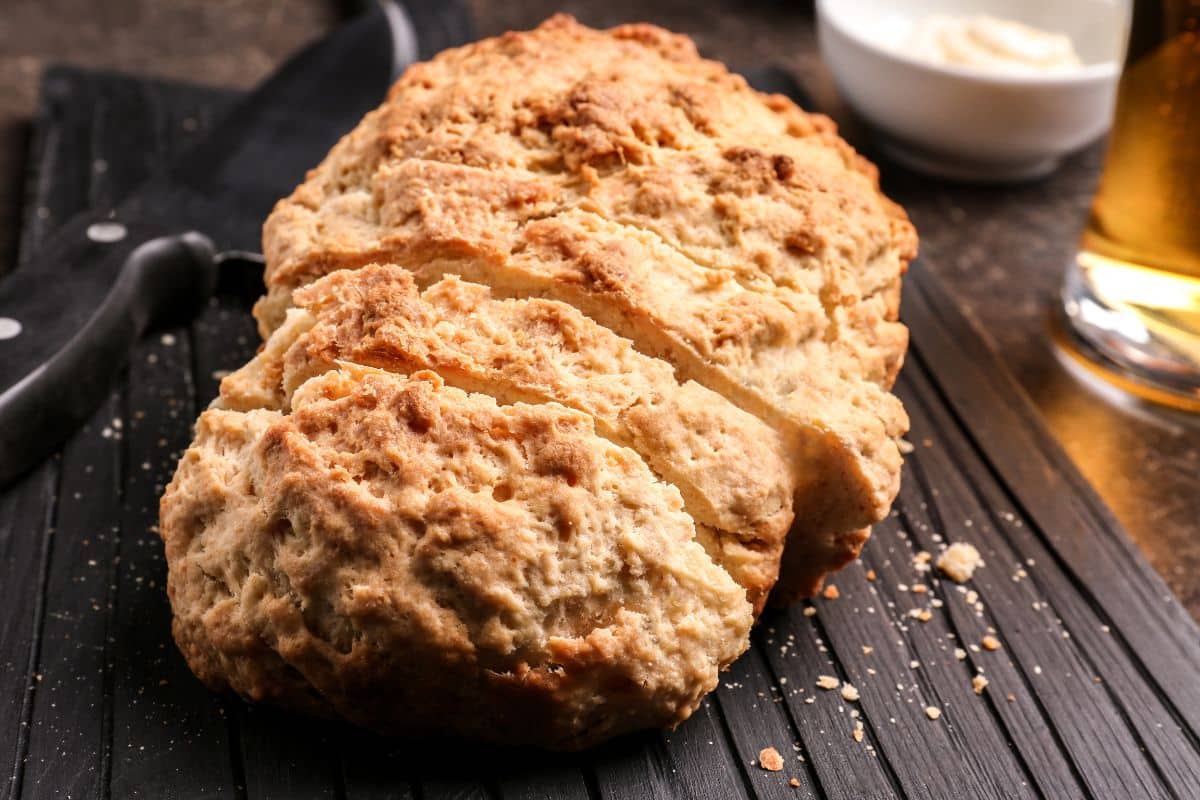
Origin of Beer Bread: Beer bread is a type of quick bread that traces its roots to the United States during the 19th century. As the name suggests, it is made using beer as a key ingredient, which contributes to its unique flavor and texture.
Beer Bread Ingredients: Beer bread typically consists of self-rising flour, sugar, and, of course, beer. Some recipes may include additional ingredients like butter or herbs for added flavor. The leavening agent is the carbonation in the beer, which creates bubbles that help the bread rise. The ingredients are mixed together to form a batter-like dough, which is then baked in a loaf pan. Darker beers impart richer, maltier notes while lighter beers add a more subtle flavor. Beer bread is also a quick and convenient way to make fresh bread at home without the need for yeast and extended rising times, making it a popular choice for novice bakers.
How to Eat Beer Bread: It’s often served as a savory side dish, snack, or appetizer. The beer imparts a subtle yeasty and malty flavor to the bread, making it a great accompaniment to soups, stews, or as a base for sandwiches. Many enjoy it with a smear of butter or even use it as a canvas for creative toppings like cheese, herbs, or garlic.
Biscuits
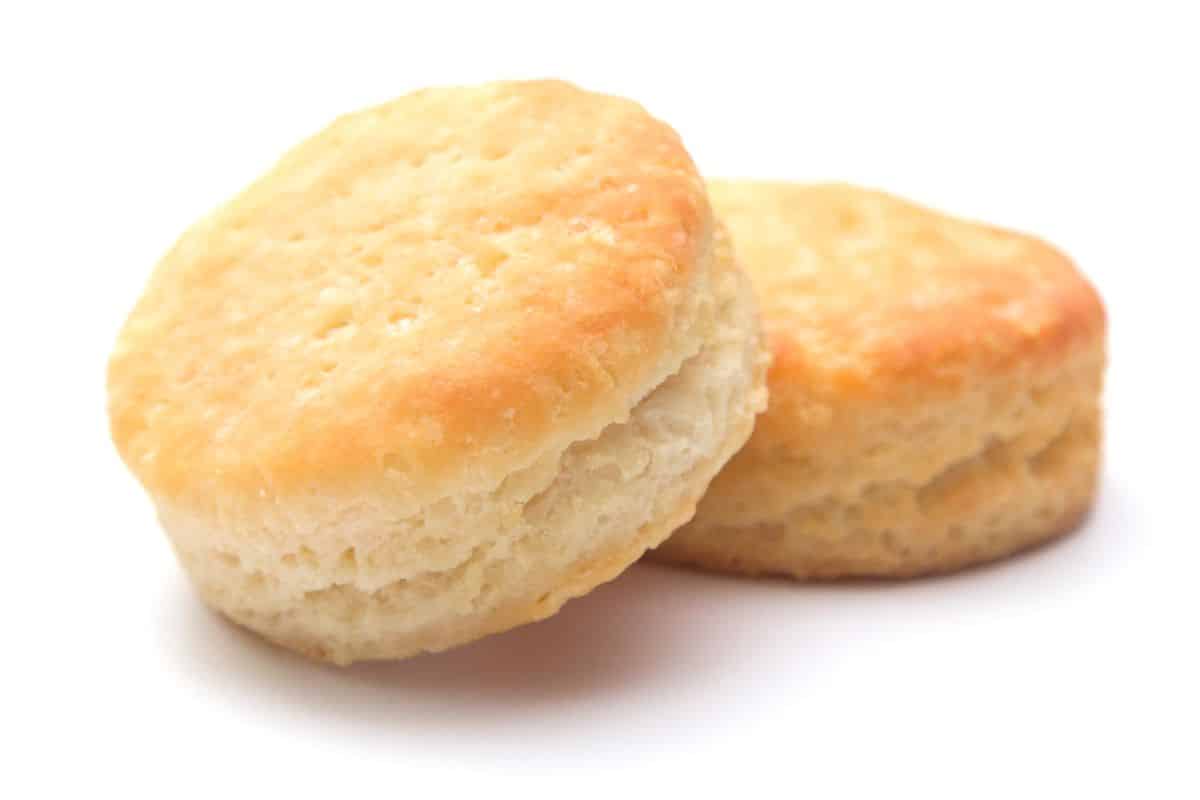
Origin of Biscuits: The ubiquitous breakfast biscuits we all know are an American invention. They are a type of quick bread that is typically small, round, and flaky. They are known for their tender, crumbly texture and are a staple of Southern American cuisine. Biscuits were once harder than we make them today.
Biscuits Ingredients: Biscuits are made using a simple combination of ingredients such as flour, cold fat (usually butter, shortening, or lard), a leavening agent (baking powder or baking soda), and liquid (often buttermilk or milk). The dough is gently mixed, rolled or patted out, and cut into rounds before baking in a hot oven. The cold fat creates layers in the dough as it melts during baking, resulting in the characteristic flakiness of biscuits. The leavening agents cause the biscuits to rise and become airy.
How to Eat Biscuits: In the US they are often served as a side dish for breakfast or dinner. For breakfast, they are often served as “biscuits and gravy.” Pork was cheap, so people combined port drippings with flour to make the pork gravy that became so famous. Biscuits also pair well with butter and jam or honey. Additionally, you can try them with fresh herbs and greek yogurt in my Herb Laminated Greek Yogurt Biscuits.
Bread Pudding
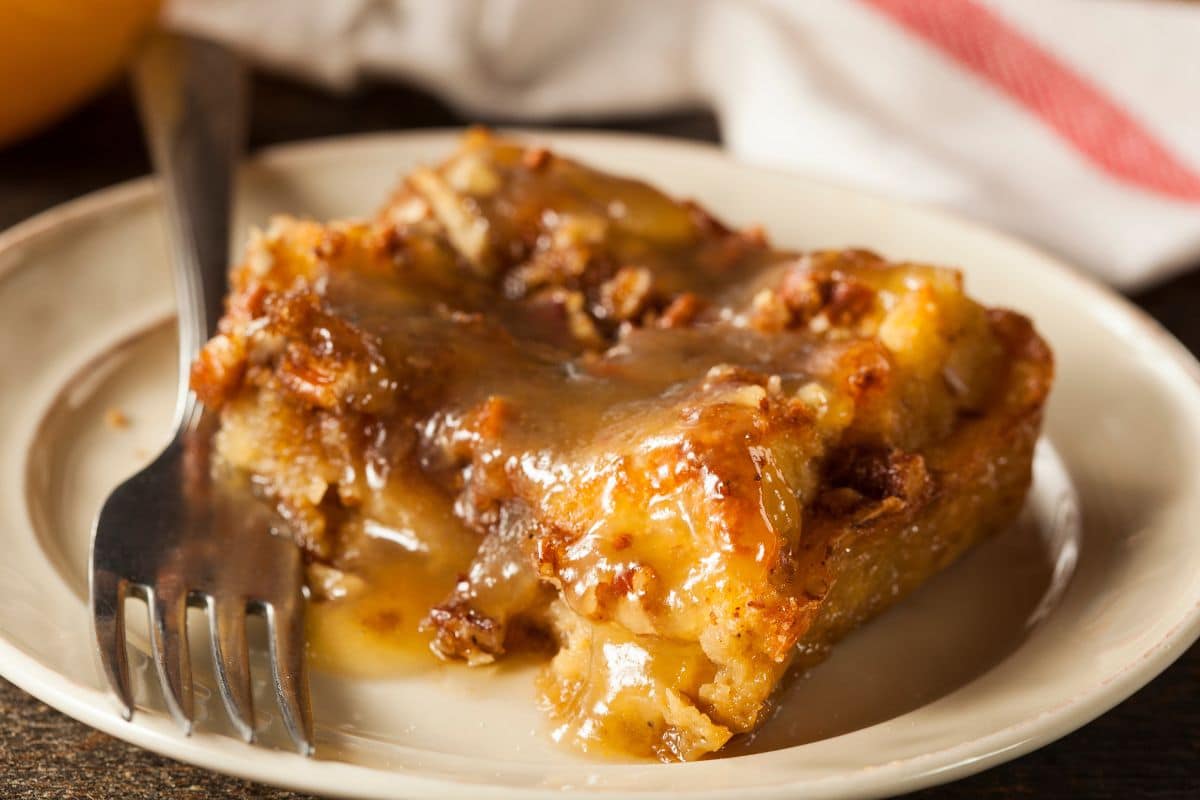
Origin of Bread Pudding: Bread pudding traces its origins back to medieval Europe. It was initially a frugal way to use up stale bread and avoid food waste.
Bread Pudding Ingredients: The core ingredients of bread pudding are bread, milk, eggs, and sugar. The bread is typically stale or day-old, as it absorbs the custard mixture better. To prepare bread pudding, you begin by layering the bread in a baking dish and then pouring the milk, sugar, and egg mixture over it. Flavorings like vanilla, cinnamon, and nutmeg are commonly added for a rich taste. The dessert is then baked until it sets and forms a golden crust on top.
How to Eat Bread Pudding: It is often eaten warm with a drizzle of sauce, such as caramel, vanilla custard, or whiskey sauce. Some people like to add fruit, nuts, or chocolate chips to enhance the flavor and texture. Bread pudding can also be eaten cold, and leftover servings are easily reheated.
Brioche Bread
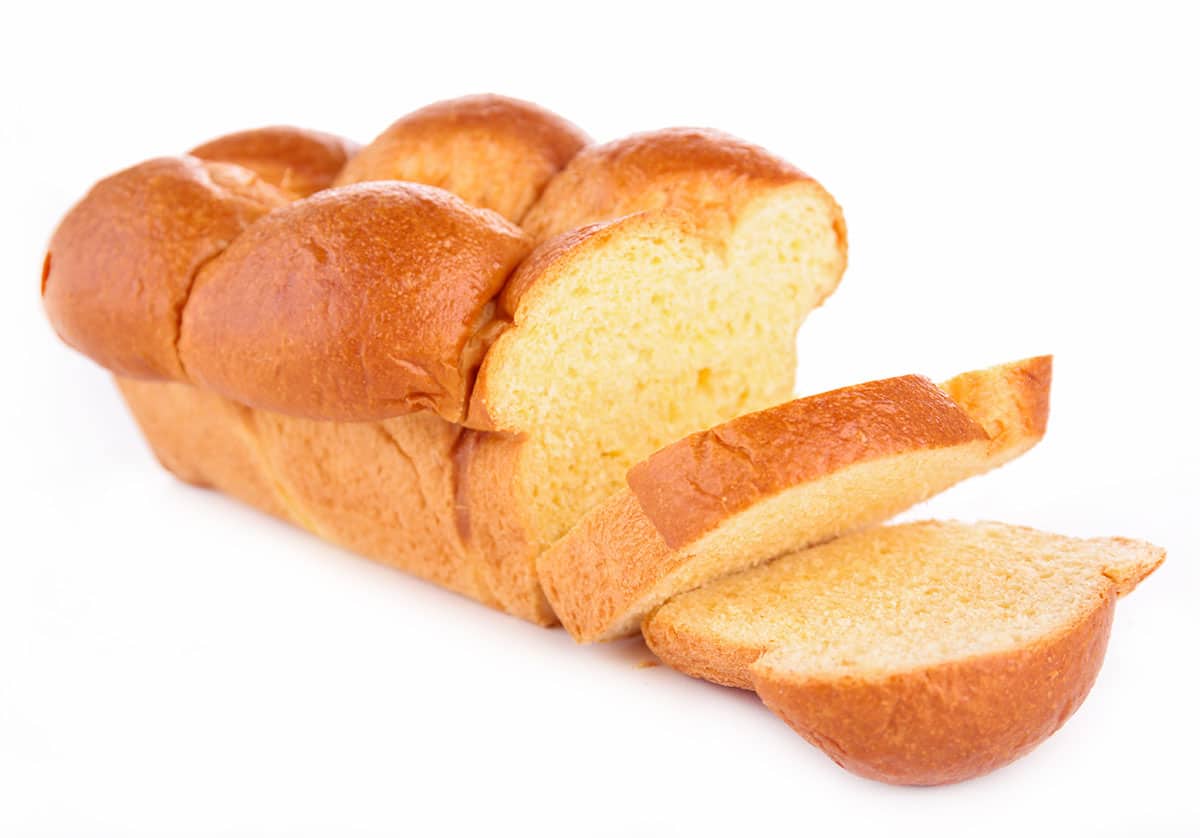
Origin of Brioche Bread: Brioche is a French bread that originated in Normandy. It is a rich and tender bread that blurs the line between bread and pastry. Brioche is known for its soft, slightly sweet, and buttery flavor. It often takes on different forms, including the classic round loaf, braided shapes, or individual buns. Brioche is popular for both its use in sweet applications, like French toast and pastries, as well as savory dishes. Brioche’s name is derived from the Old French word “broyer,” which means “to knead” or “to mix.” Its association with French royalty and aristocracy dates back to the 17th century when it became a symbol of wealth and indulgence.
Brioche Bun Ingredients: Brioche is made with high-quality ingredients, including flour, eggs, sugar, milk or water, yeast, and, a generous amount of butter. The dough is mixed and kneaded until it becomes elastic and smooth, then it’s left to rise, which allows it to develop its rich flavor. The butter is often added in stages, incorporating it into the dough gradually. This results in the bread’s signature buttery, melt-in-the-mouth texture. The addition of butter in brioche dough is what gives it its distinctive flavor and texture, and it’s often said that the more butter, the better the brioche.
How to Eat Brioche: In France, it’s often eaten as a breakfast bread, spread with jam or chocolate-hazelnut spread. It’s also used to make exquisite French pastries like pain aux raisins and tarte tropézienne. On the savory side, brioche can be used for sandwiches or as an accompaniment to pâté and cheeses. Its slightly sweet flavor makes it a popular choice for desserts like bread pudding or as the base for luxurious French toast.
Brown Bread
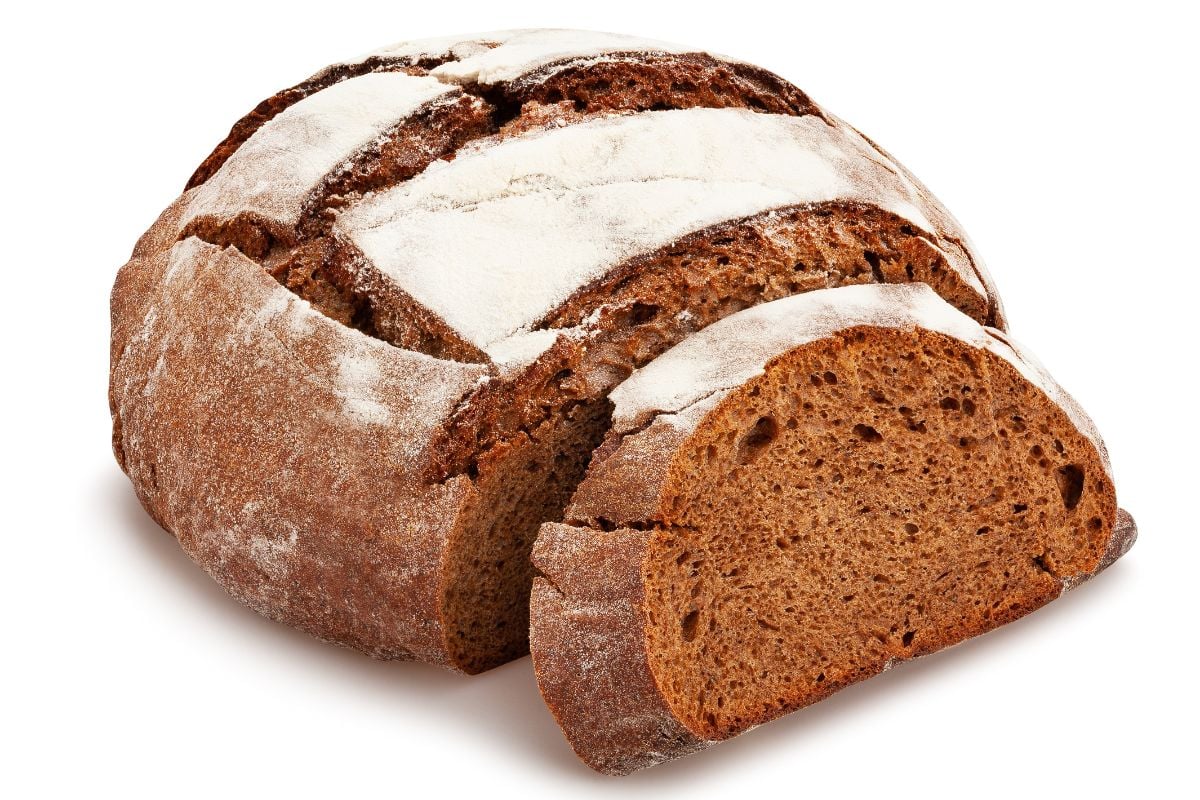
Origin of Brown Bread: Also known as whole wheat bread, is a type of bread made from whole wheat flour, which includes the bran, germ, and endosperm of the wheat kernel. It is known for its brownish color and nuttier flavor compared to traditional white bread. The concept of brown bread has ancient origins, with whole grains being a staple in many traditional diets worldwide.
Brown Bread Ingredients: Brown bread is made primarily from whole wheat flour, water, yeast or a leavening agent, salt, and sometimes a sweetener like molasses or honey. The inclusion of the whole wheat kernel components gives brown bread a denser texture and a characteristic earthy flavor. The dough is mixed, allowed to rise, shaped into loaves, and then baked. Some variations may also include seeds or nuts for added texture and flavor.
How to Eat Brown Bread: Brown bread is a nutritious choice often used for sandwiches, providing a heartier and more substantial base compared to white bread. Brown bread pairs well with a variety of toppings, from classic deli fillings to vegetarian options like hummus and roasted vegetables. It’s also commonly toasted with butter or served alongside soup.
Ciabatta Bread
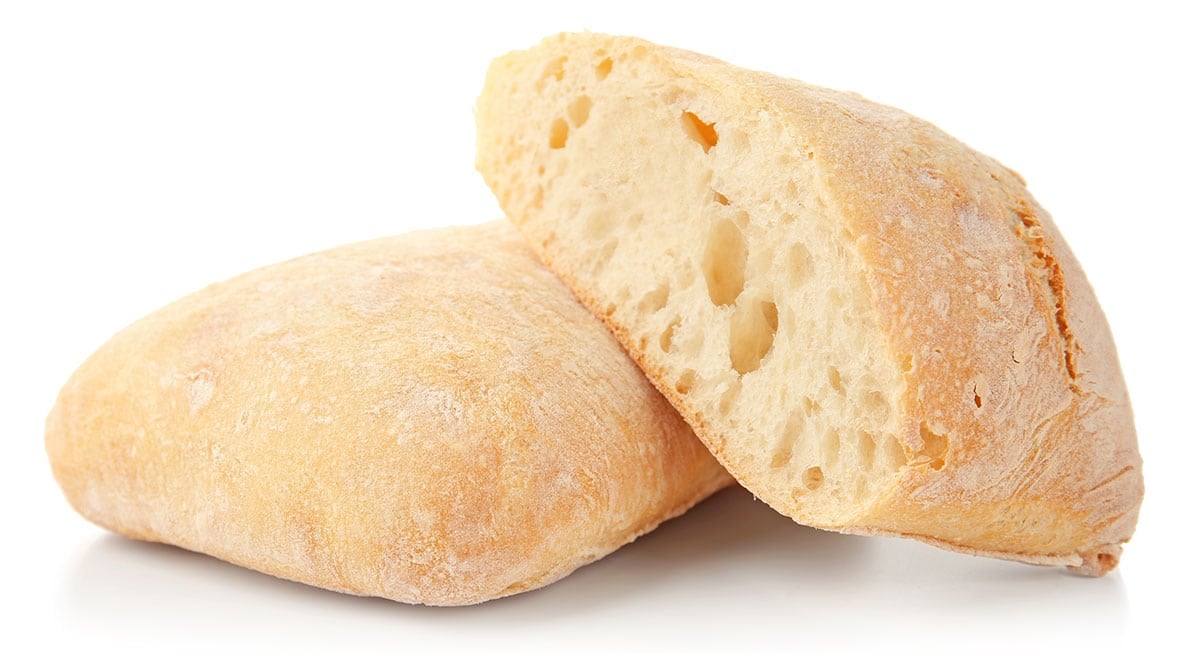
Origin of Ciabatta Bread: Ciabatta bread originated in Italy’s Veneto region less than 50 years ago. The name “ciabatta” means “slipper” in Italian, and it’s believed to refer to the shape of the bread. Ciabatta is a rustic, crusty bread with a soft and airy interior. It’s characterized by its irregular shape, large air pockets, and a crisp crust.
Ciabatta Bread Ingredients: Traditional ciabatta bread is made from flour, water, yeast, salt, and sometimes a small amount of olive oil. The dough is typically very wet, which gives ciabatta its characteristic open crumb structure. It’s made by mixing the ingredients and allowing the dough to ferment for an extended period to develop its flavor. Afterward, it’s shaped into long, flat loaves and baked, creating a distinct crust and airy interior. The high hydration of ciabatta dough, which makes it quite sticky and challenging to work with, is a key factor in achieving its chewy texture.
How to Eat Ciabatta Bread: It is a staple in Italian cuisine, often used for sandwiches, bruschettas, or served as a side with olive oil and balsamic vinegar. In sandwiches its crust holds up well to various fillings. It’s fantastic when used for paninis, as it crisps up beautifully when grilled. Additionally, you can slice and toast ciabatta to create bruschettas or serve it as an accompaniment to soups, salads, and pasta dishes. It’s also excellent when dipped in olive oil and balsamic vinegar.
Challah Bread
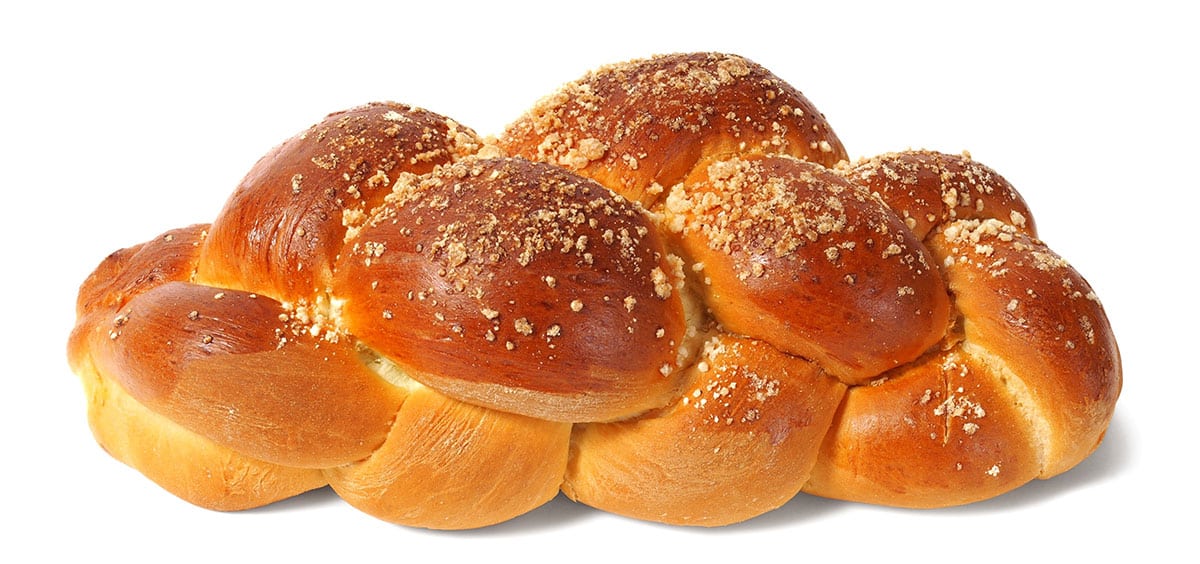
Origin of Challah Bread: Challah bread is part of Jewish cuisine from Eastern Europe. It is a rich slightly sweet bread, traditionally braided, and associated with Jewish Sabbath and holiday meals. Challah is known for its golden-brown crust and soft, slightly eggy interior. The braided shape of challah is said to symbolize various aspects of Jewish life and tradition, such as unity and the double portion of manna that fell from the heavens during the Sabbath for the Israelites in the desert.
Challah Bread Ingredients: It is made from flour, water, yeast, eggs, sugar, salt, and sometimes oil. The inclusion of eggs and sugar gives it a subtly sweet flavor and a tender crumb. Challah dough is prepared, braided into various shapes (typically a three-strand braid for regular occasions and a six-strand braid for special occasions), and then baked until golden brown. The original challah was not as sweet as the American version today that includes more sugar, eggs, and poppy seeds.
How to Eat Challah Bread: It is often a centerpiece during Jewish Sabbath dinners and holiday meals. It’s customary to start the meal by reciting a blessing and then breaking the bread. Challah is also excellent for making French toast, sandwiches, or simply slicing and spreading with butter or honey. It can also be used in various recipes like bread puddings and stuffing.
Cloud Bread
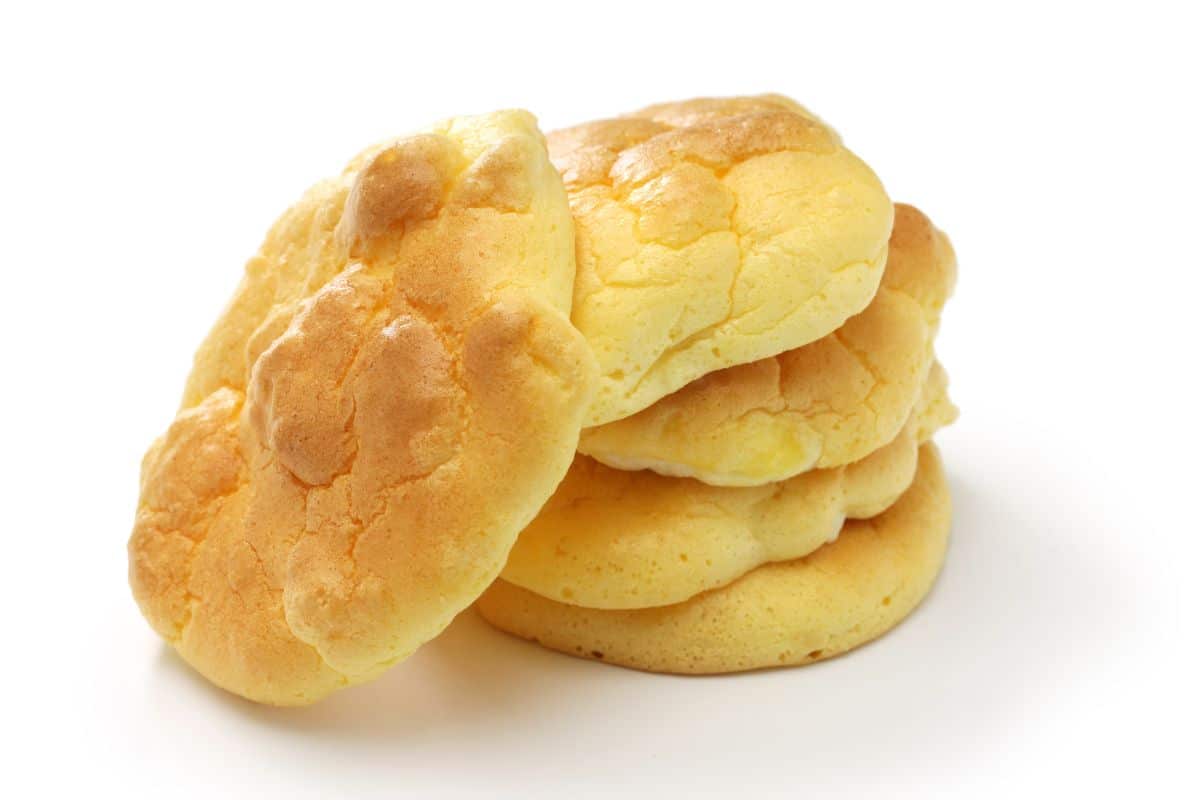
Origin of Cloud Bread: Cloud bread, also known as “oopsie bread,” is a low-carb, gluten-free alternative to traditional bread. Its origin is often attributed to the rise of low-carb and ketogenic diets. Cloud bread is distinct from conventional bread in that it doesn’t contain flour. The result is a light, fluffy, and cloud-like texture, hence its name.
Cloud Bread Ingredients: To make cloud bread, you’ll typically need eggs, cream cheese, cream of tartar, and a sweetener (like sugar or a sugar substitute). The yolks and whites of the eggs are separated. The whites are whipped with cream of tartar until stiff peaks form, while the yolks are combined with cream cheese and sweetener. These two mixtures are then gently folded together before being baked into individual rounds. The result is a bread substitute that’s high in protein and low in carbs.
How to Eat Cloud Bread: It is generally used as a substitute for traditional bread in low-carb or gluten-free diets.
Cornbread
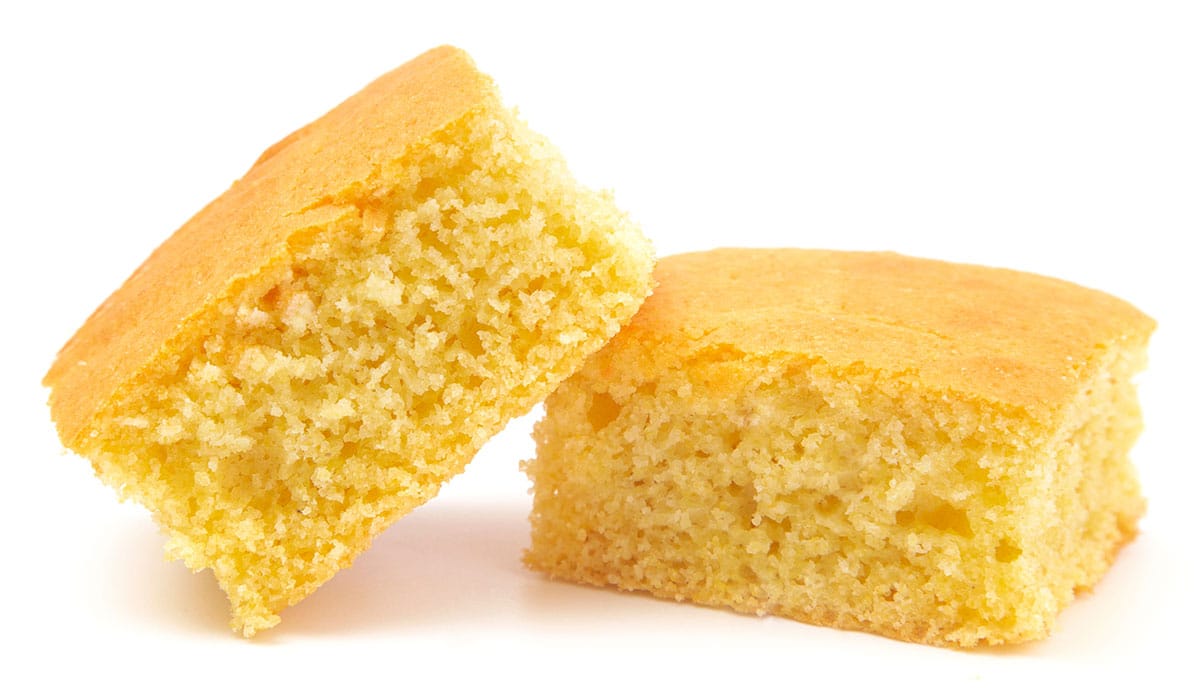
Origin of Cornbread: Cornbread originated as a Native American cuisine, particularly among the indigenous tribes of the southeastern United States for whom corn was a dietary staple. It’s a type of bread made primarily from cornmeal, giving it a distinctive flavor and texture. Cornbread comes in various forms, including southern-style skillet cornbread, cornbread casserole, and sweeter variations like cornbread cake. It’s a popular accompaniment to southern dishes and barbecue.
Cornbread Ingredients: Cornbread typically consists of cornmeal, wheat flour (or sometimes just cornmeal), baking powder, salt, sugar, liquid (usually buttermilk or milk), and a fat source, often butter or bacon drippings. The ingredients are mixed together to form a batter, which is then baked in an oven or fried in a skillet. The result is a bread with a slightly crumbly texture, a slightly sweet taste, and a golden-brown crust.
How to Eat Cornbread: Cornbread is commonly served as an accompaniment to chili, barbecue, or fried chicken. It’s also a staple at Thanksgiving dinners. In some regions, it’s eaten with a drizzle of honey or maple syrup. Cornbread can be used as a base for stuffing, crumbled into soups, or just eaten on its own with butter. The debate over whether cornbread should be sweet or savory has sparked regional variations and passionate discussions among food enthusiasts. Southern-style cornbread tends to be less sweet, while northern versions are often sweeter.
Crumpets
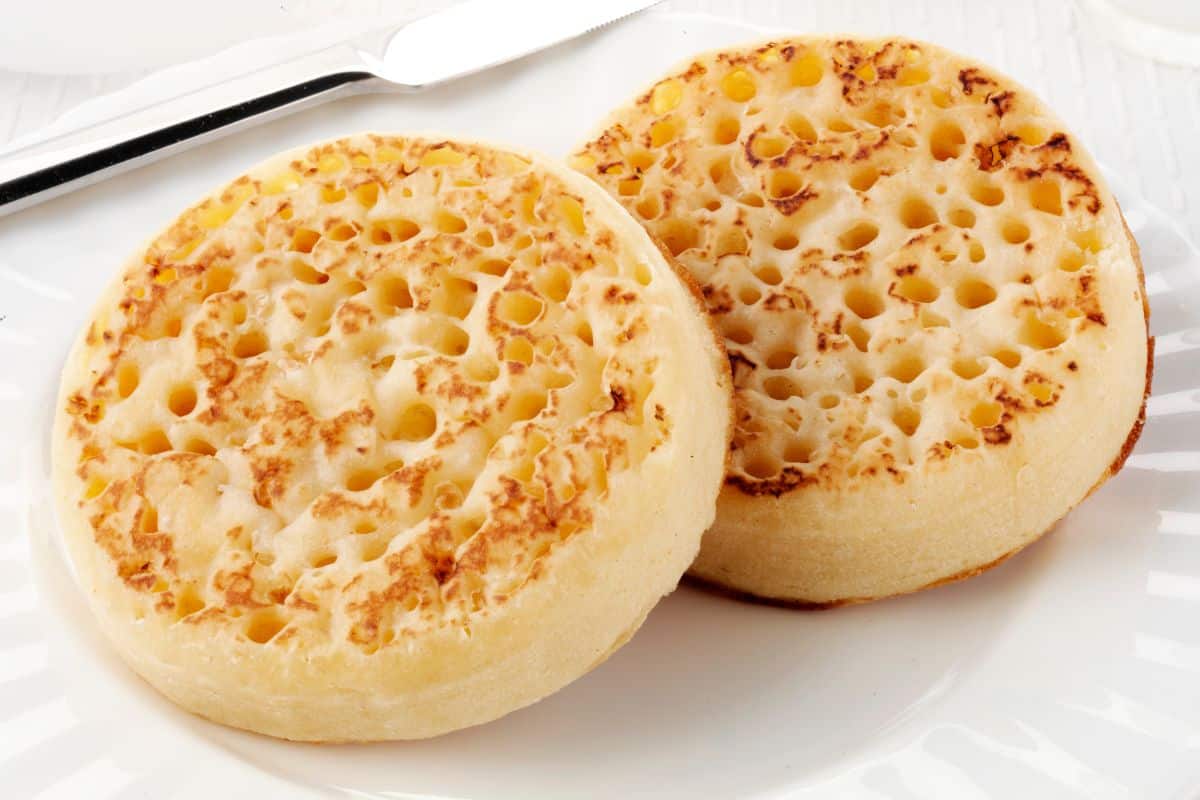
Origin of Crumpets: Crumpets are a distinctly British type of griddle cake. They are round, flat, and have a distinctive appearance with small holes or bubbles on the surface. Crumpets are similar in some ways to English muffins, but they have a distinct texture and flavor due to their unique preparation method. The word “crumpet” likely comes from the Welsh word “crempog,” which refers to a type of pancake or griddle cake.
Crumpet Ingredients: Crumpets are made from a relatively simple batter that includes flour, water or milk, yeast, salt, and sometimes sugar or honey. The batter is allowed to rise, and then baking powder is added, creating the characteristic bubbles. The batter is cooked on a griddle or in special crumpet rings until it’s set and golden brown on the bottom, leaving the top side with its signature holes.
How to Eat Crumpets: They are typically toasted and then served warm with butter and various toppings. Traditional toppings include butter and jam, honey, or golden syrup. In some cases, they can be used as a base for savory toppings like cheese or spreads. Crumpets are a popular choice for afternoon tea or as a breakfast treat in the UK.
English Muffin
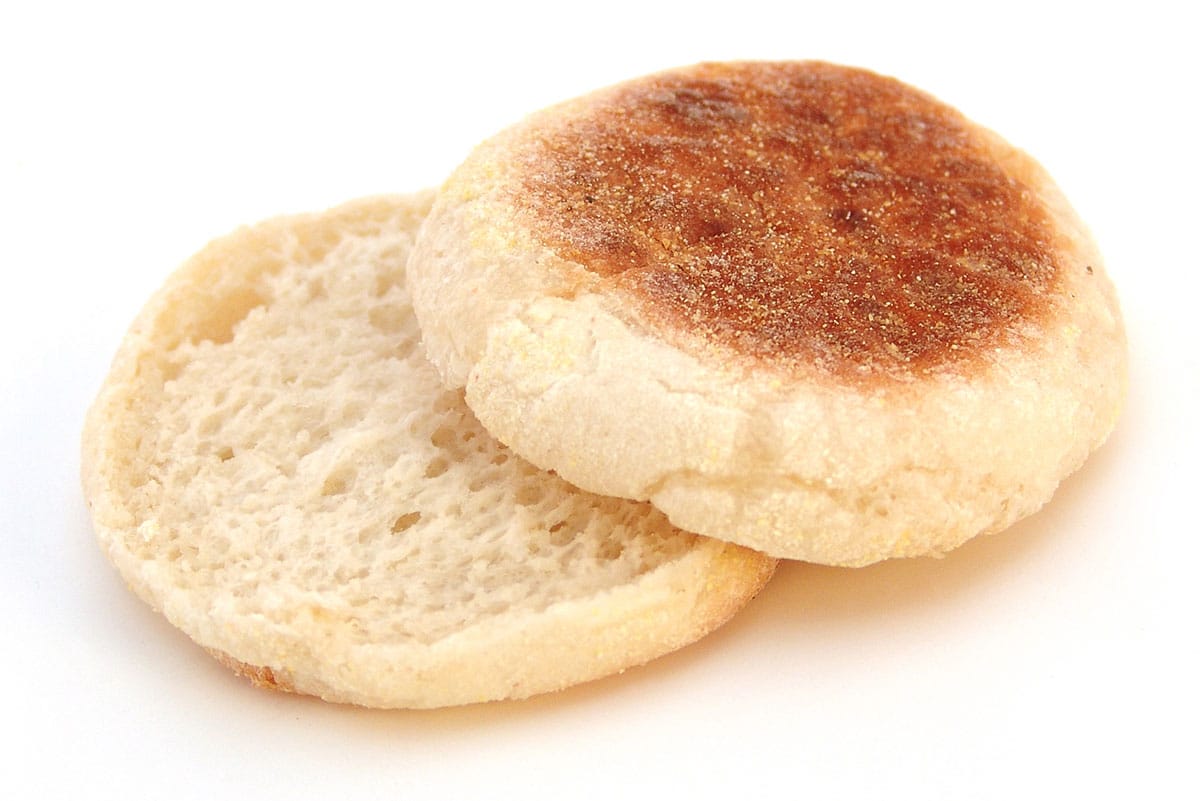
Origin of English Muffins: The invention of the English muffin is often credited to Samuel Bath Thomas, an English immigrant who opened a bakery in New York City in the late 19th century. His Thomas’ English Muffins brand became famous. They are small, round, and flat bread-like cakes with a slightly crispy crust and a soft, porous interior.
English Muffin Ingredients: They are made from a dough that typically includes flour, water, yeast, salt, and sometimes a bit of sugar. The dough is mixed, allowed to rise, and then divided into portions and shaped into rounds. These rounds are griddled or cooked on a hot surface, such as a griddle or skillet, which gives them their characteristic texture and appearance. They’re usually cooked on both sides until golden brown.
How to Eat English Muffins: They are usually split in half horizontally and toasted. Once toasted, they can be spread with butter, jam, peanut butter, or used as a base for breakfast sandwiches with eggs, cheese, and various toppings. English muffins gained popularity in the United States as a breakfast item as the iconic “Egg McMuffin” served at McDonald’s.
Flatbread
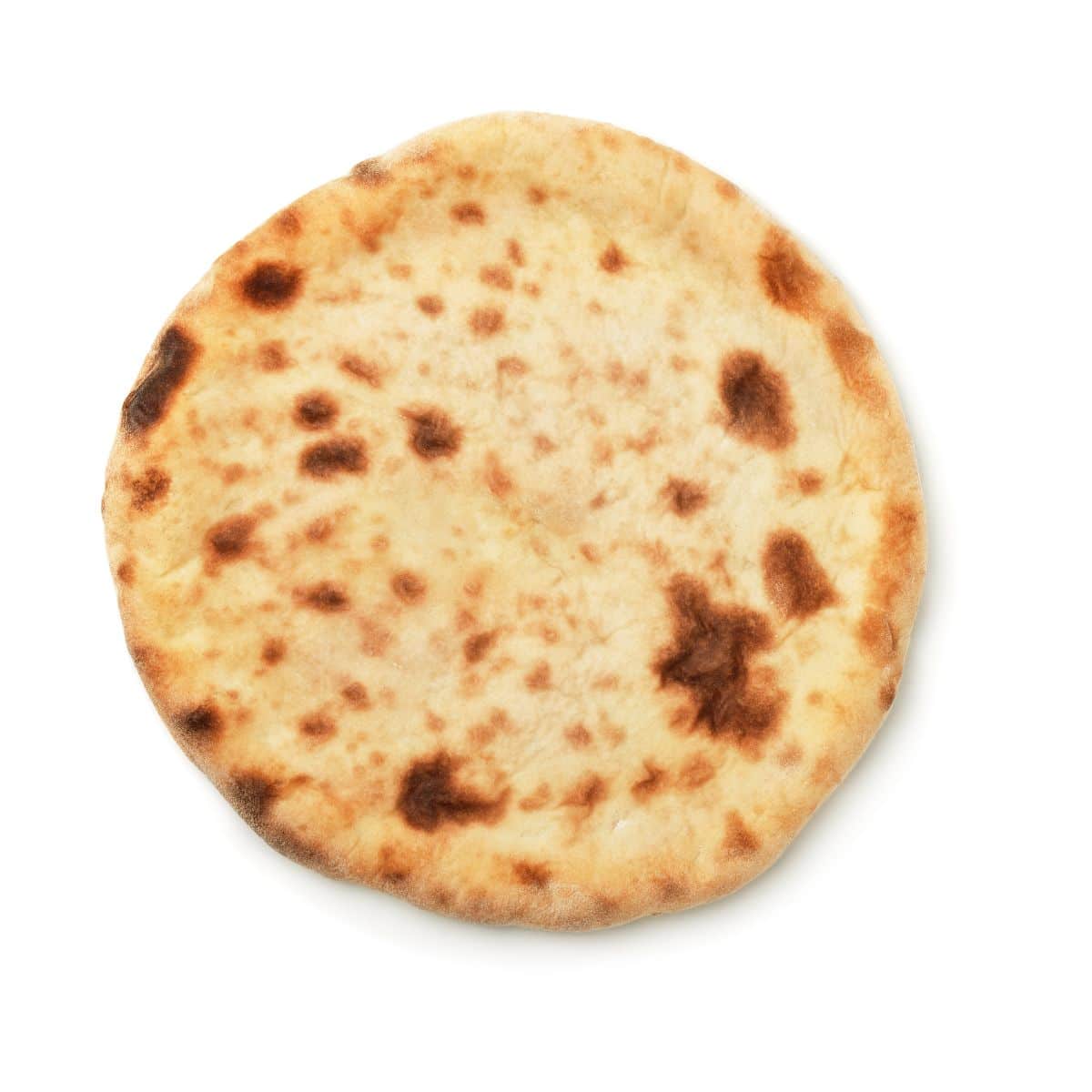
Origin of Flatbread: Flatbreads have been a part of human cuisine for thousands of years and are eaten worldwide. A variant of flatbread was almost certainly the first bread eaten by humans. Flatbreads were ideal for nomadic people as they didn’t require an oven and could be stacked for easy transport.These breads are characterized by their thin, unleavened nature, and can be made from a variety of grains, including wheat, corn, rice, and more. Flatbreads come in different shapes and sizes, such as pita, naan, tortillas, and lavash, and serve as a staple food in many regions.
Flatbread Ingredients: The ingredients for flatbreads can vary depending on the type and regional preferences, but a basic recipe includes flour, water, and salt. Some variations might incorporate oil, yogurt, or other flavorings. The dough is typically rolled out into thin, flat sheets and then cooked on a hot surface, such as a griddle or an open flame. The absence of yeast or baking powder in most flatbreads results in their thin, flexible, and often slightly chewy texture.
How to Eat Flatbreads: They can be used as wraps or pizza bases. Flatbreads such as naan, are great for dipping, and yet others, like lavash, can be used for making sandwiches or rolled up with various fillings.
Focaccia Bread
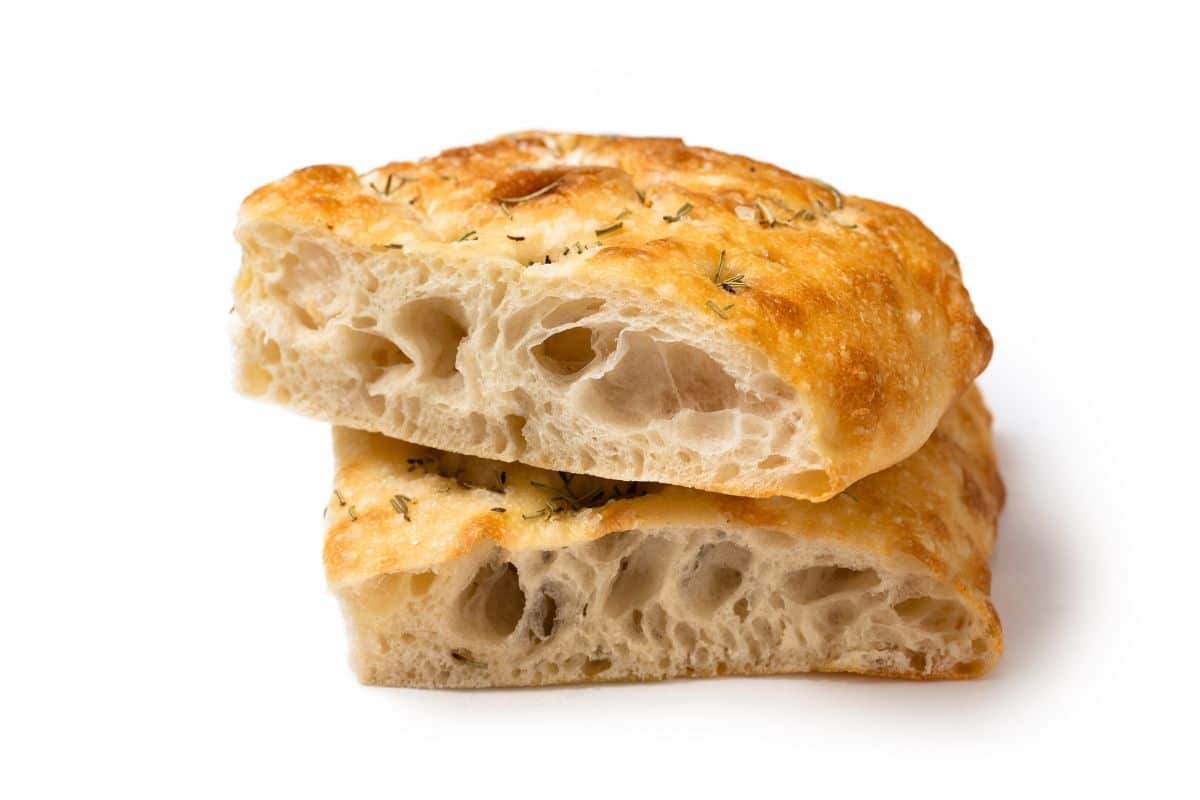
Origin of Focaccia Bread: Focaccia is an Italian flatbread that hails from the Liguria region and has a history dating back centuries. Focaccia is typically flavored with olive oil, salt, and herbs, giving it a savory and aromatic quality. It’s known for its dimpled surface, which holds pools of olive oil and toppings.
Focaccia Bread Ingredients: Focaccia dough is made from flour, water, yeast, salt, spices, and olive oil. After mixing and kneading the dough, it’s allowed to rise before being stretched or pressed into a flat, rectangular shape. Just before baking, the dough is dimpled with the fingers, creating small pockets. Olive oil is generously drizzled over the surface, and it’s often topped with ingredients like rosemary, garlic, cherry tomatoes, or olives. Focaccia is then baked until it’s golden brown and has a crispy crust.
How to Eat Focaccia Bread: Focaccia is often served as an appetizer, cut into squares or strips, and accompanied by dips or spreads like olive tapenade or hummus. Focaccia can also be used as a sandwich bread or served as a side with soups and salads. Some enjoy it as a snack on its own or as a base for pizza toppings. We like to make a large pan, and freeze some of it. It can be put frozen directly in the air fryer when needed.
Gluten-Free Bread
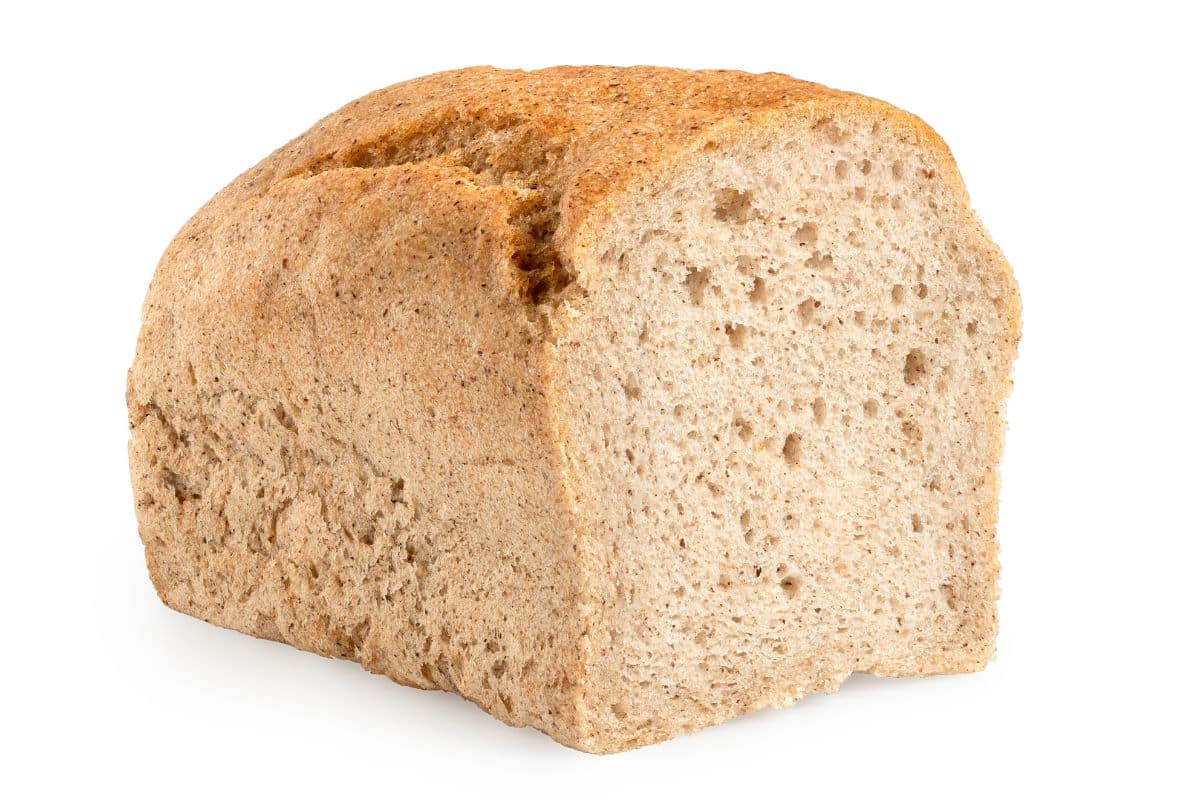
What is Gluten-Free Bread: Gluten-free bread is a type of bread specially designed for individuals with gluten intolerance or celiac disease. Gluten is a protein found in wheat, barley, and rye, and consuming it can cause severe health issues for those with gluten-related disorders. Gluten-free bread is a viable alternative that allows people to enjoy the taste and texture of bread without these concerns.
Gluten-Free Bread Ingredients: Gluten-free bread is typically made from a combination of alternative flours and starches, such as rice flour, cornstarch, potato starch, and tapioca flour. These ingredients are mixed with water, eggs, and various binding agents like xanthan gum or psyllium husk to create dough. Unlike traditional bread, which relies on gluten for elasticity, gluten-free bread often requires additional leavening agents like yeast or baking powder to help it rise. The dough is then baked in the same way as regular bread.
How to Eat Gluten-free Bread: You can generally use it like any other bread, but due to its different texture and taste compared to wheat-based bread, some may prefer to toast it before consumption for added crispness and flavor. The demand for gluten-free products has skyrocketed in recent years, leading to a growing variety of gluten-free bread options, including baguettes, ciabatta, and even artisanal styles.
Hokkaido Bread
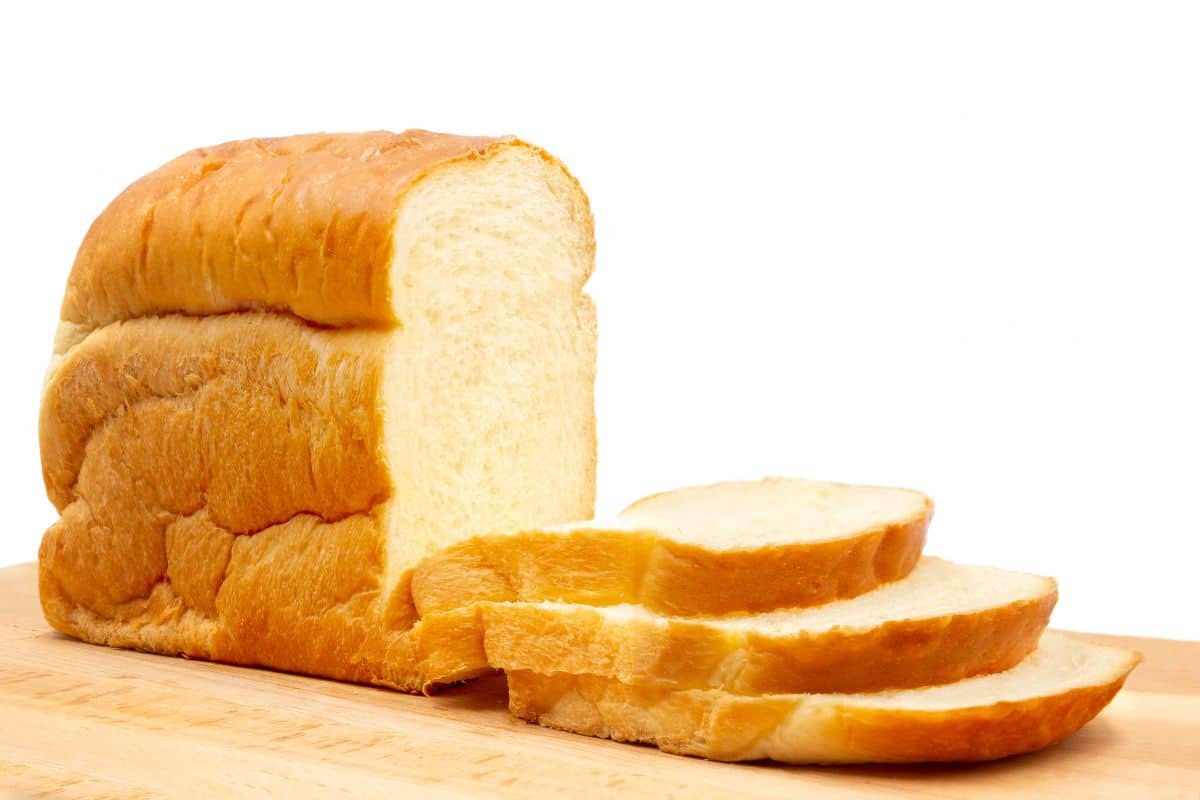
Origin of Hokkaido Bread: Also known as “Shokupan” in Japan, it originated in Hokkaido, the northernmost island of Japan. It is a type of soft, fluffy, and slightly sweet white bread. Hokkaido bread has gained popularity worldwide for its unique texture and flavor, but wasn’t actually developed until after WWII. Bread was not a strong Japanese tradition before the war, but the USA shipped wheat to Japan after the war to make up for rice shortages.
Hokkaido Bread Ingredients: It is made using a combination of flour, yeast, sugar, milk, and salt. What sets it apart is the “Tangzhong” method, a Japanese technique where a portion of the flour and liquid (usually milk or water) is cooked into a paste before adding it to the rest of the dough ingredients. This method helps retain moisture, resulting in the bread’s signature softness and fluffiness. The Tangzhong method used in making Hokkaido bread was originally developed in Japan as a way to make Western-style bread more suitable for Japanese tastes. It has since become a standard practice in Japanese bread baking.
How to Eat Hokkaido Bread: Hokkaido is often eaten on its own, in sandwiches, or as a base for French toast. Hokkaido bread is often used in making katsu sandwiches, a Japanese favorite that combines crispy breaded meat (usually pork or chicken) with the soft, sweet bread.
Irish Soda Bread
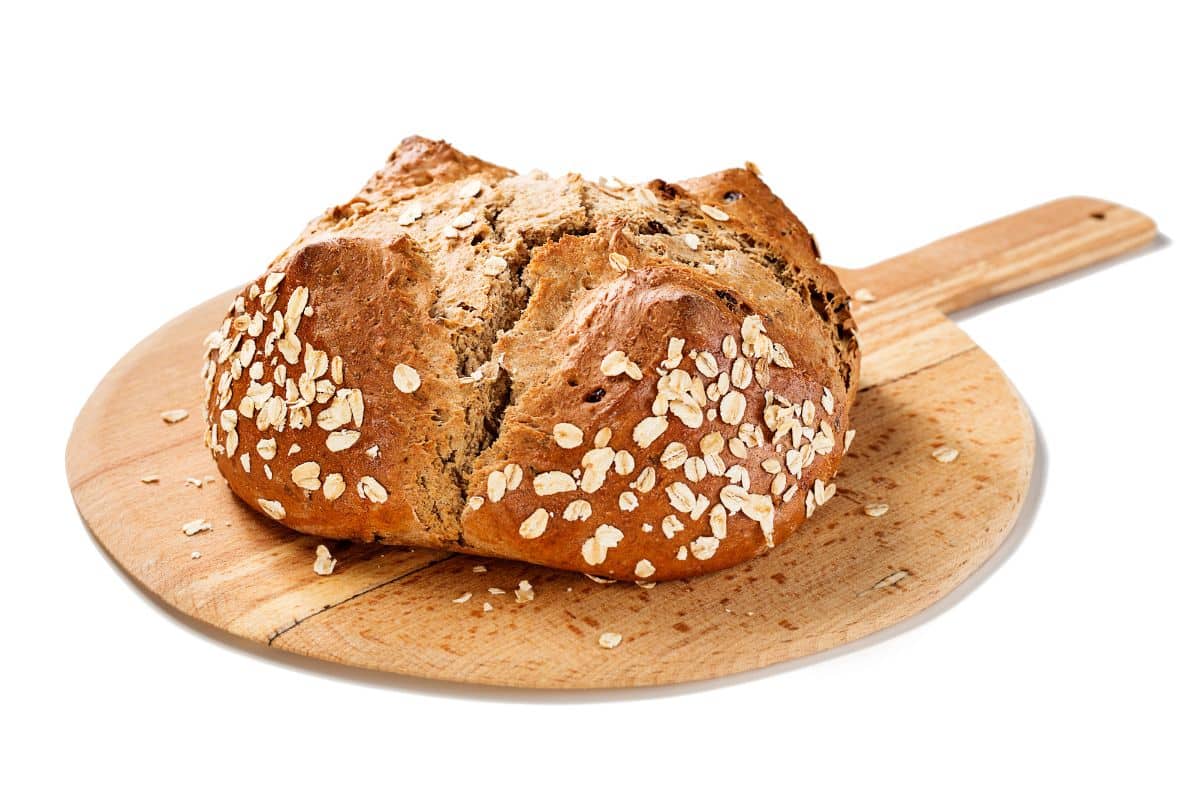
Origin of Irish Soda Bread: This is a traditional Irish bread dating back to the 19th century. It is a type of quick bread that relies on baking soda (bicarbonate of soda) as the leavening agent instead of yeast. Soda bread has a distinct crusty exterior and a dense, slightly crumbly interior. Traditional Irish soda bread has a cross scored on the top of the loaf. This isn’t just for decoration; it’s believed to ward off evil spirits and protect the household.
Irish Soda Bread Ingredients: The basic ingredients are flour, baking soda, salt, and buttermilk. Some variations may include raisins or currants, resulting in a sweeter, fruit-studded version known as “spotted dog.” The buttermilk reacts with the baking soda to create carbon dioxide gas, which leavens the bread during baking. There are other variants including whole wheat versions and those with added seeds or nuts for extra flavor and texture.
How to Eat Irish Soda Bread: It is typically sliced and served with butter or jam. It’s a classic accompaniment to hearty Irish stews and soups. The dense texture of soda bread makes it excellent for soaking up sauces and gravies.
Italian Bread
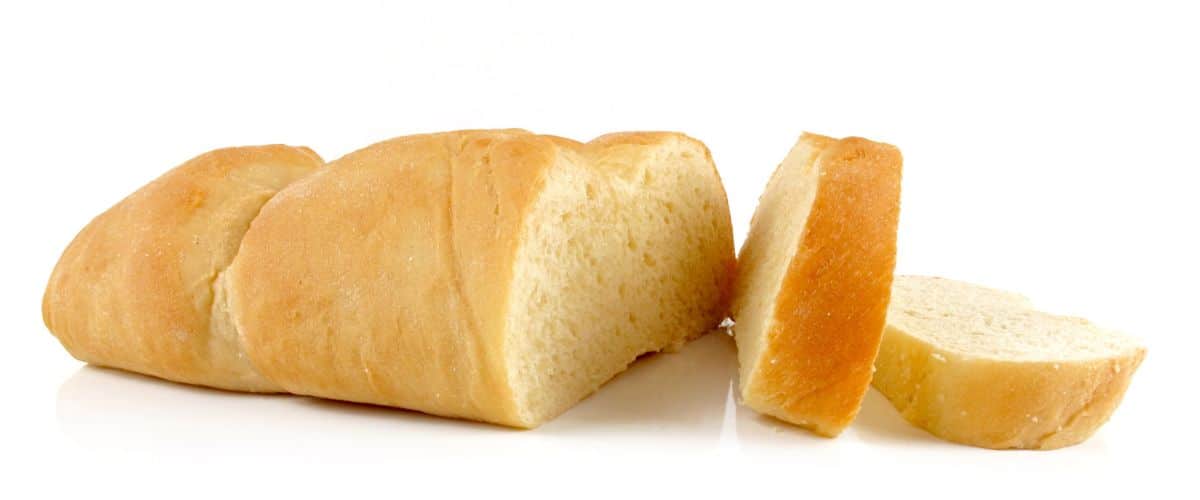
Origin of Italian Bread: “Pane Italiano,” is a classic type of bread originating from Italy. It is known for its rustic, chewy crust and soft, airy interior. Italian bread is one of the foundational bread types in Italian cuisine and is used worldwide. The “baguette,” was inspired by Italian bread-making techniques brought to France by Italian bakers in the early 19th century. The Romans were the first society to systematically mill flour for bread on an industrial scale.
Italian Bread Ingredients: The core ingredients for Italian bread are flour, water, salt, and yeast. The key to its distinct flavor and texture is a long fermentation process, which allows the dough to develop complex flavors and a chewy crust. Italian bread dough is typically mixed, kneaded, and then left to ferment for an extended period, sometimes up to 24 hours. It’s often shaped into a long, oval loaf before being baked in a hot oven, producing a beautiful golden-brown crust.
How to Eat Italian Bread: It’s commonly used for making sandwiches, like the Italian sub or panini. You can also use it to dip into olive oil and balsamic vinegar, or simply enjoy it as a side to pasta dishes, soups, or salads. The crusty exterior and soft interior make it an excellent choice for a wide range of toppings and fillings. Italian bread is often considered at its best when freshly baked. It has a relatively short shelf life due to its lack of preservatives, which makes it a staple at local bakeries and markets in Italy.
Monkey Bread
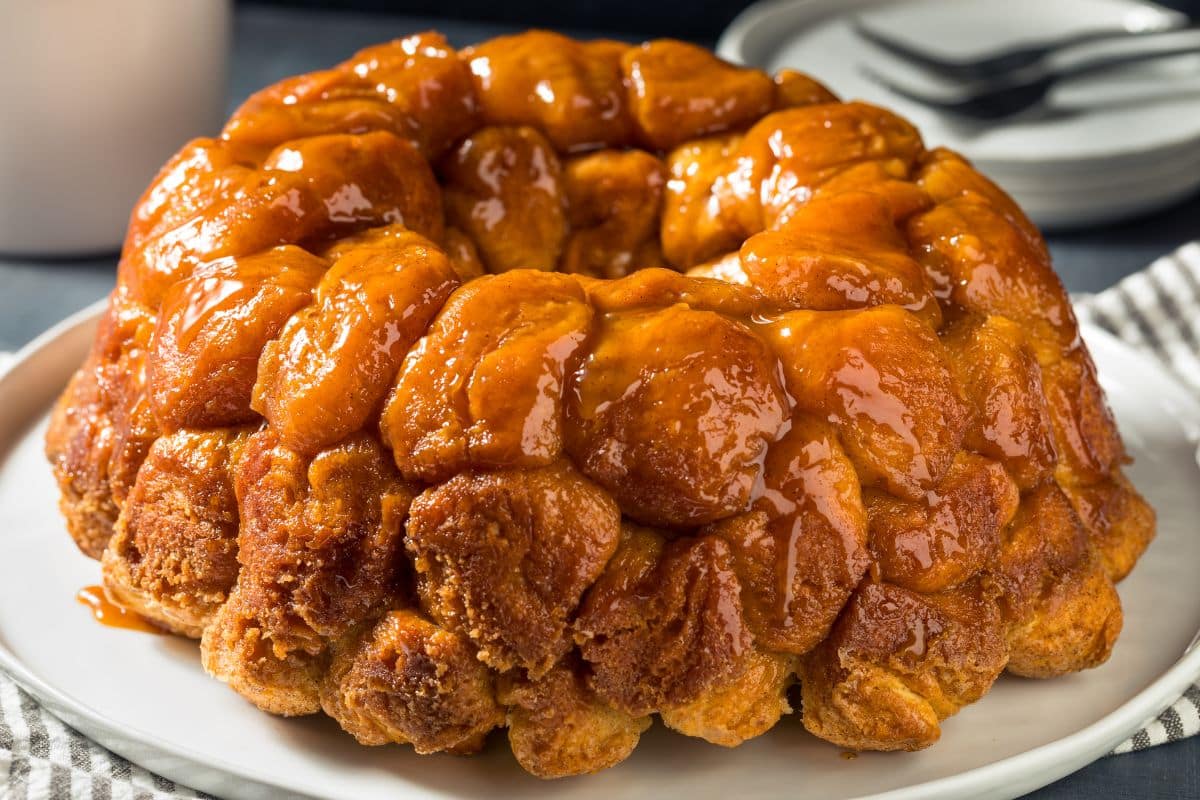
Origin of Monkey Bread: Also known as “monkey puzzle bread” or “pull-apart bread,” it is believed to have originated in Hungary or Germany, but was initially a savory bread. Today It’s a sweet, sticky, and fun-to-eat bread that’s typically served as a dessert or breakfast treat. Monkey bread gets its name from the playful way it’s eaten, with individuals pulling apart small, gooey chunks.
Monkey Bread Ingredients: Monkey bread is made from balls or chunks of dough that are coated in a mixture of sugar, cinnamon, and butter. These dough pieces are then stacked into a bundt pan or similar container, where they bake together. The sugar and butter mixture caramelizes, creating a sticky, sweet glaze that surrounds each piece of bread. While traditional monkey bread is sweet and cinnamon-flavored, there are savory versions that use ingredients like cheese, herbs, and garlic instead of sugar and cinnamon.
How to Eat Monkey Bread: Monkey bread is designed to be fun. You simply pull apart the gooey individual cinnamon-infused pieces. It’s best served warm.
Multigrain Bread
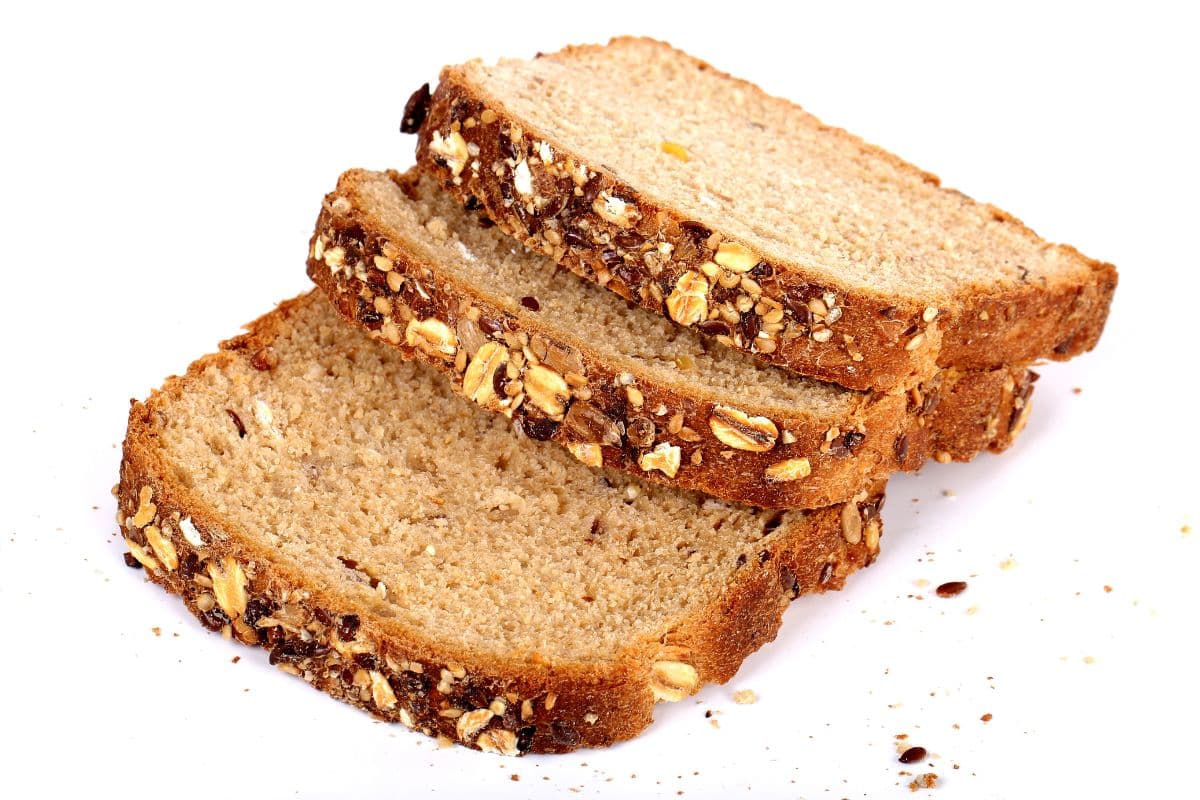
Origin of Multigrain Bread: Multigrain bread incorporates various grains and seeds into its dough, making it a healthier and more nutrient-rich option compared to traditional white bread. Its exact origin is hard to trace, but it gained popularity in the late 20th century as people became more health-conscious and interested in diverse grain sources.
Multigrain Bread Ingredients: Multigrain bread typically includes a mixture of whole grains, such as wheat, oats, and barley, along with various seeds like sunflower, flax, and sesame seeds. Some multigrain bread recipes may incorporate ancient grains like quinoa and amaranth, adding even more nutritional value. These grains and seeds are combined with flour, water, yeast, and sometimes a touch of honey or molasses for sweetness. The dough is kneaded, left to rise, and then baked until it forms a golden-brown crust.
How to Eat It Multigrain Bread: Well, pretty much like any other bread. It makes an excellent base for sandwiches,and can be toasted and served with butter or your favorite spreads, like jam or peanut butter. While multigrain bread is often associated with health benefits, it’s essential to read labels carefully, as some commercial versions may still contain refined flours and added sugars.
Naan Bread
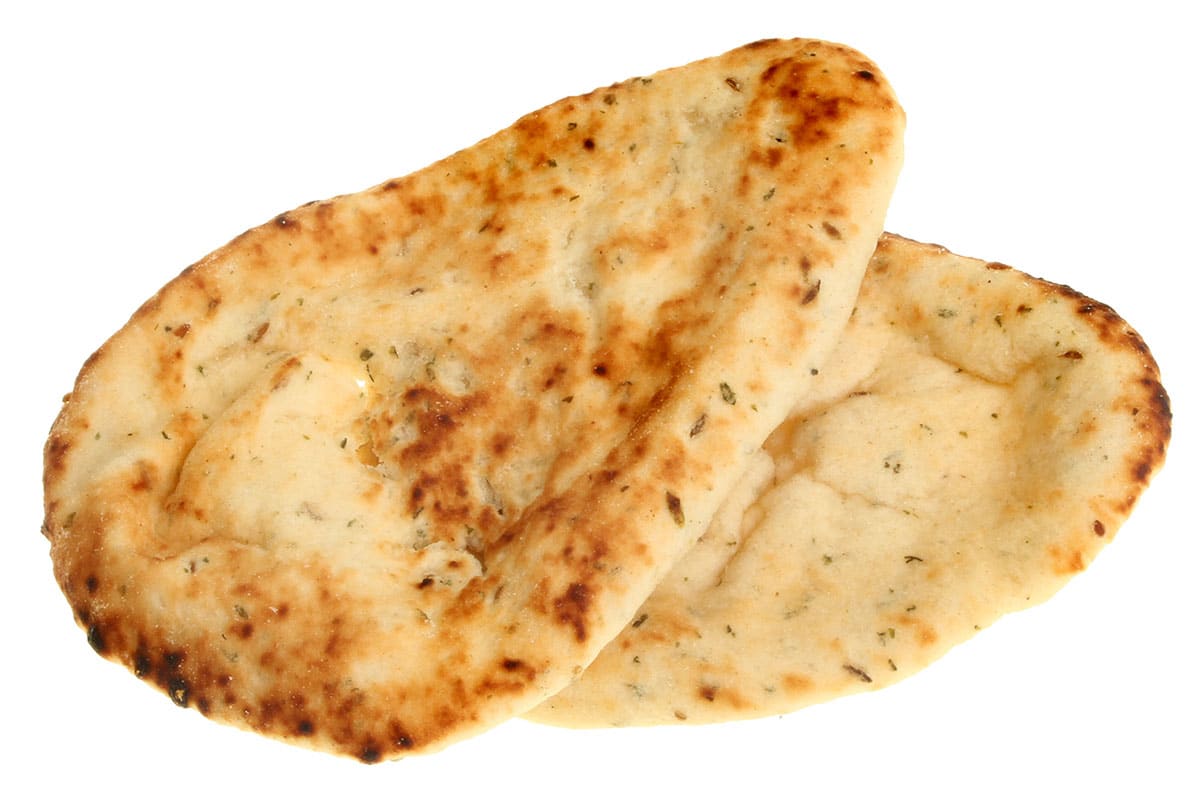
Origin of Naan: Naan is a flatbread from southern Asia, specifically India, Pakistan, and Afghanistan, and likely originated around 1300 CE. It’s a leavened bread, traditionally cooked in a tandoor, which is a cylindrical clay oven. Naan is known for its soft, slightly chewy texture and delicious flavor. It’s a staple in South Asian cuisine, and is often served as an accompaniment to curries, kebabs, and other dishes.
Naan Bread Ingredients: The primary ingredients for naan include flour, water, yeast, yogurt, and sometimes milk or ghee (clarified butter). Variations of naan include garlic naan, butter naan, and cheese naan. The dough is typically allowed to rise, which gives naan its characteristic fluffiness. After the dough has risen, it’s divided into portions, rolled out into thin rounds, and then cooked in the tandoor oven. Modern adaptations of naan may use conventional ovens or stovetops for cooking.
How to Eat Naan: It’s perfect for scooping up flavorful sauces and curries due to its soft texture. You can also use it as a wrap for sandwiches or fill it with ingredients like grilled meats, vegetables, and sauces. Naan can even be eaten by itself, brushed with butter or garlic for extra flavor. Naan has gained worldwide popularity and can be found in many international restaurants, often served with a variety of dishes beyond South Asian cuisine.
Paratha Flatbread
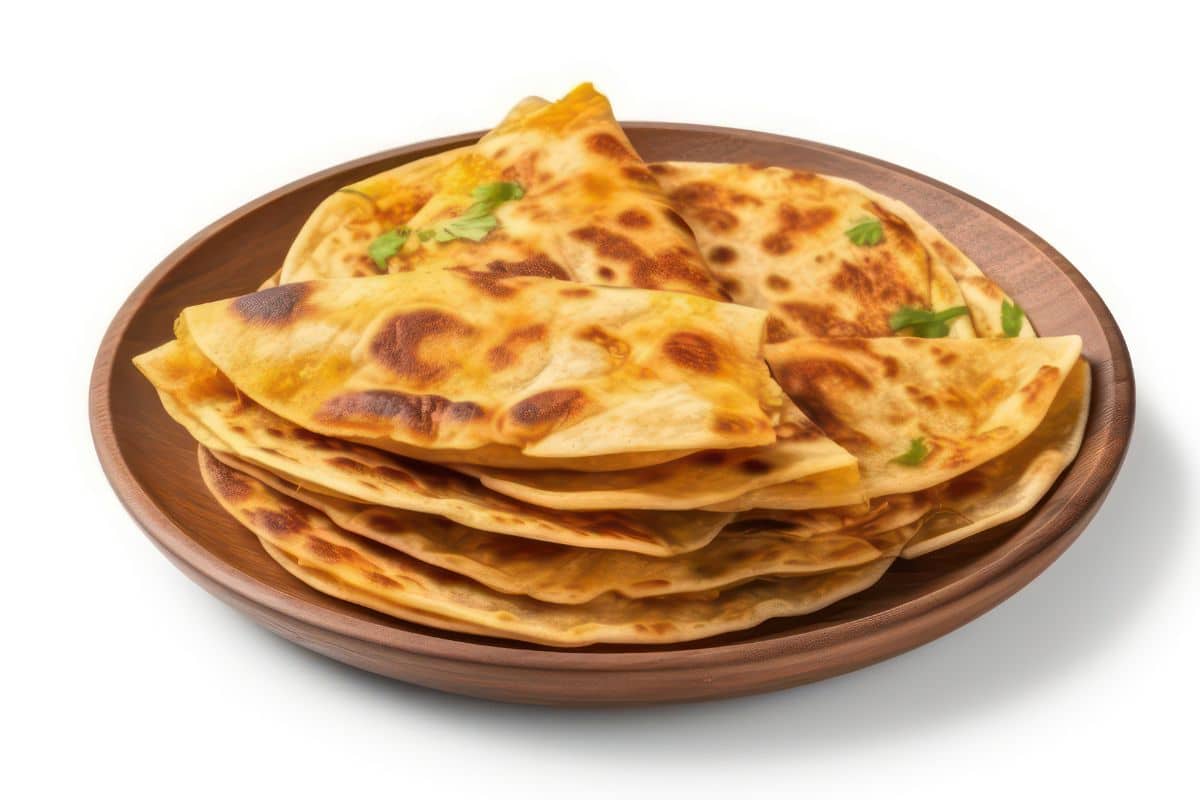
Origin of Paratha Flatbread: Paratha is a traditional Indian flatbread.
Paratha Flatbread Ingredients: Paratha is typically unleavened, and made by mixing whole wheat flour, water, a pinch of salt, and sometimes oil or clarified butter. The dough is then rolled out into thin rounds and cooked on a hot griddle or skillet. What sets paratha apart is its flaky and layered texture, achieved through a unique folding and cooking technique. The dough is folded multiple times to create layers.
How to Eat Parathas: They are often served with yogurt, pickles, chutneys, or various curries. Some popular variations of parathas include stuffed parathas, where the dough is filled with ingredients like spiced potatoes, spinach, or paneer (Indian cottage cheese). Stuffed parathas are often served with a side of raita (yogurt-based sauce). Parathas are known for their ability to stay soft even when cold, making them a convenient choice for packed lunches or travel meals.
Pita Bread
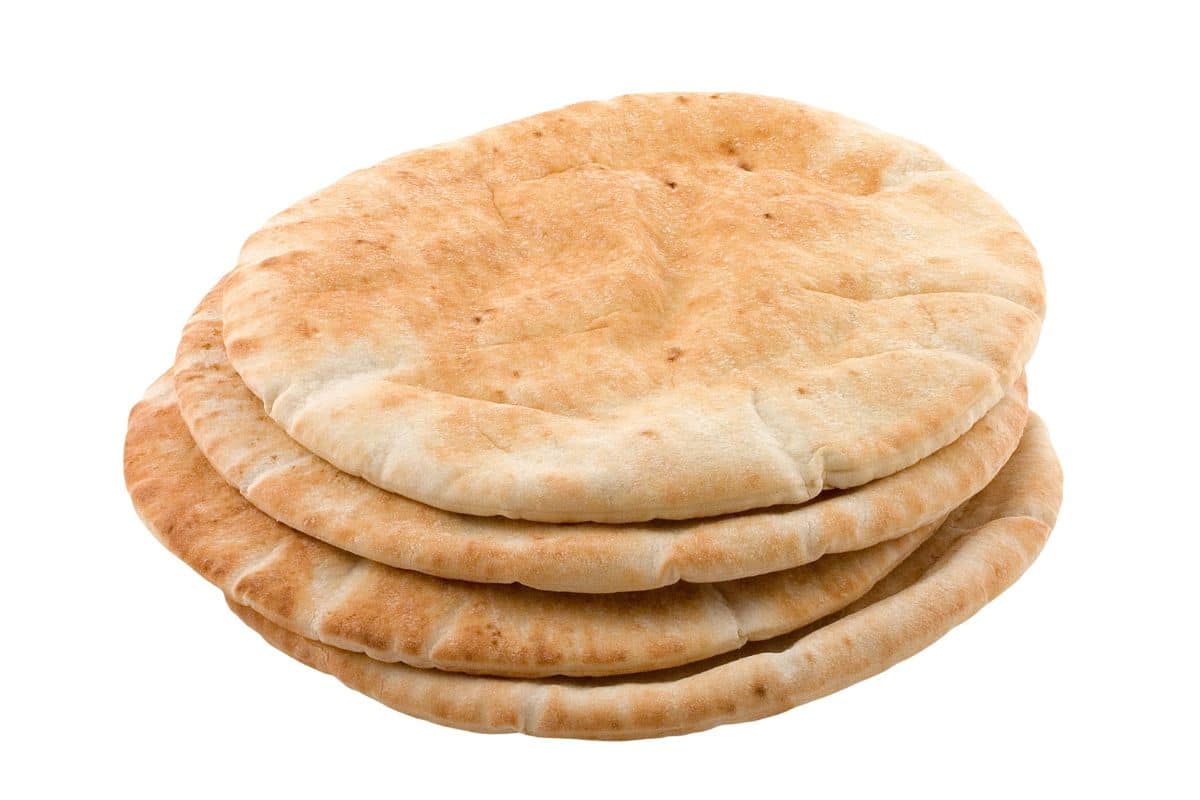
Origin of Pita Bread: Also known as Arabic bread or pocket bread, pita dates back at least 4,000 years originating in the Middle East and Mediterranean region. The word “pita” actually means “bread” in Greek. It is a round, flatbread with a unique pocket in the center, created during the baking process.
Pita Bread Ingredients: Pita bread is made from flour, water, yeast, salt, and sometimes a bit of olive oil or sugar. The dough is mixed, kneaded, and then left to rise. After rising, it is divided into small balls, which are rolled out into flat circles. These circles are baked at high temperatures, causing the bread to puff up, creating the characteristic pocket. The result is a soft, slightly chewy bread with a crispy exterior.
How to Eat Pita Bread: You have only to gently split the bread in half, and stuff it with a wide range of fillings, to make sandwiches or wraps. Common fillings include falafel, hummus, grilled meat, spreads, and various fresh vegetables. Pita bread can also be torn into pieces and used as a scoop for dips like tzatziki or baba ganoush. It’s a popular choice for making quick and convenient meals.
Potato Bread
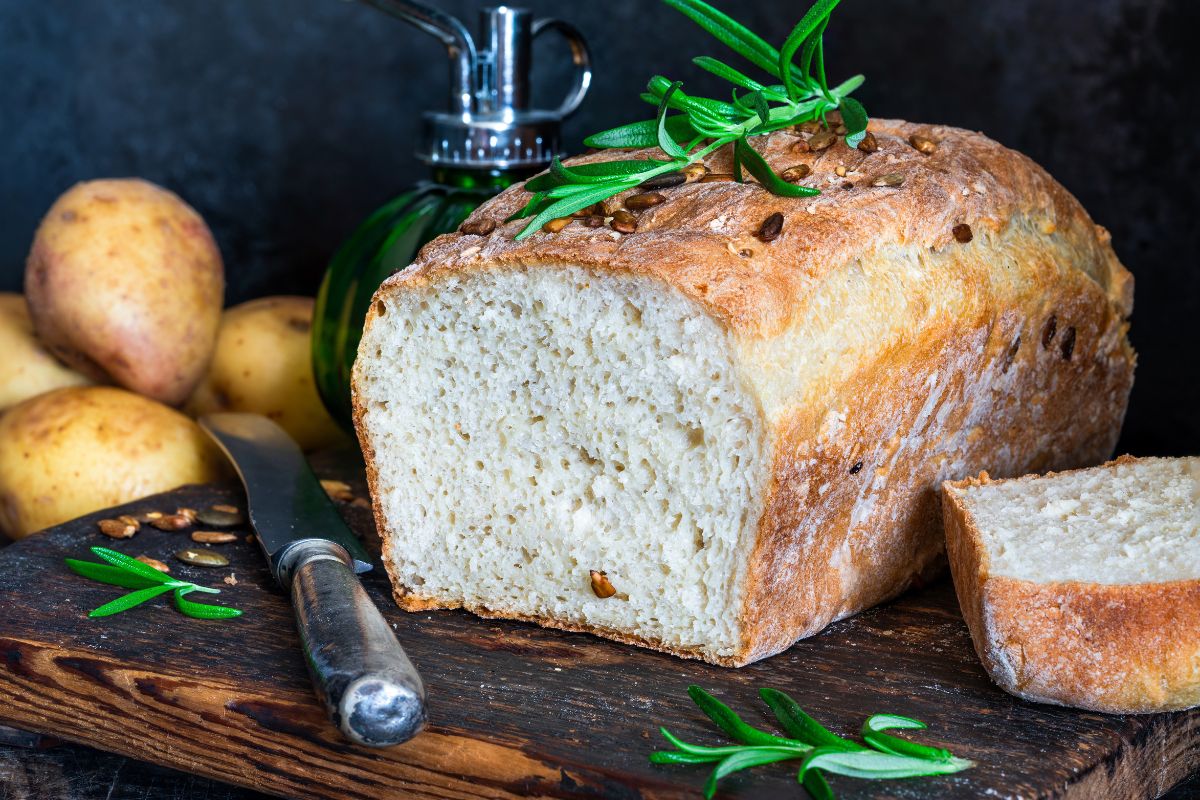
Origin or Potato Bread: Potato bread, as the name suggests, incorporates mashed or grated potatoes into the bread dough. Its exact origin is unclear, but it likely evolved as a way to add moisture and a unique flavor to bread. Potato bread gained popularity during the 19th century when potatoes became a more common staple in many households, particularly in Europe and North America.
Potato Bread Ingredients: The key ingredient in potato bread is, of course, potatoes. These can be boiled, mashed, or grated, depending on the recipe. Other typical ingredients include flour, water, yeast, sugar, salt, and sometimes a bit of butter or oil. Some variations of potato bread incorporate sweet potatoes or add-ins like herbs and cheese to enhance the flavor. The mashed potatoes add moisture to the dough, resulting in a softer texture. After mixing and kneading the ingredients, the dough is allowed to rise, shaped into loaves, and baked until golden brown.
How to Eat Potato Bread: It is great for sandwiches due to its soft and slightly sweet flavor. It pairs well with both savory and sweet fillings. It’s also a good option for making toast, as it produces a crispy crust and a tender interior. Additionally, potato bread can be used in various recipes, such as bread pudding or as a base for homemade croutons.
Pumpernickel Bread
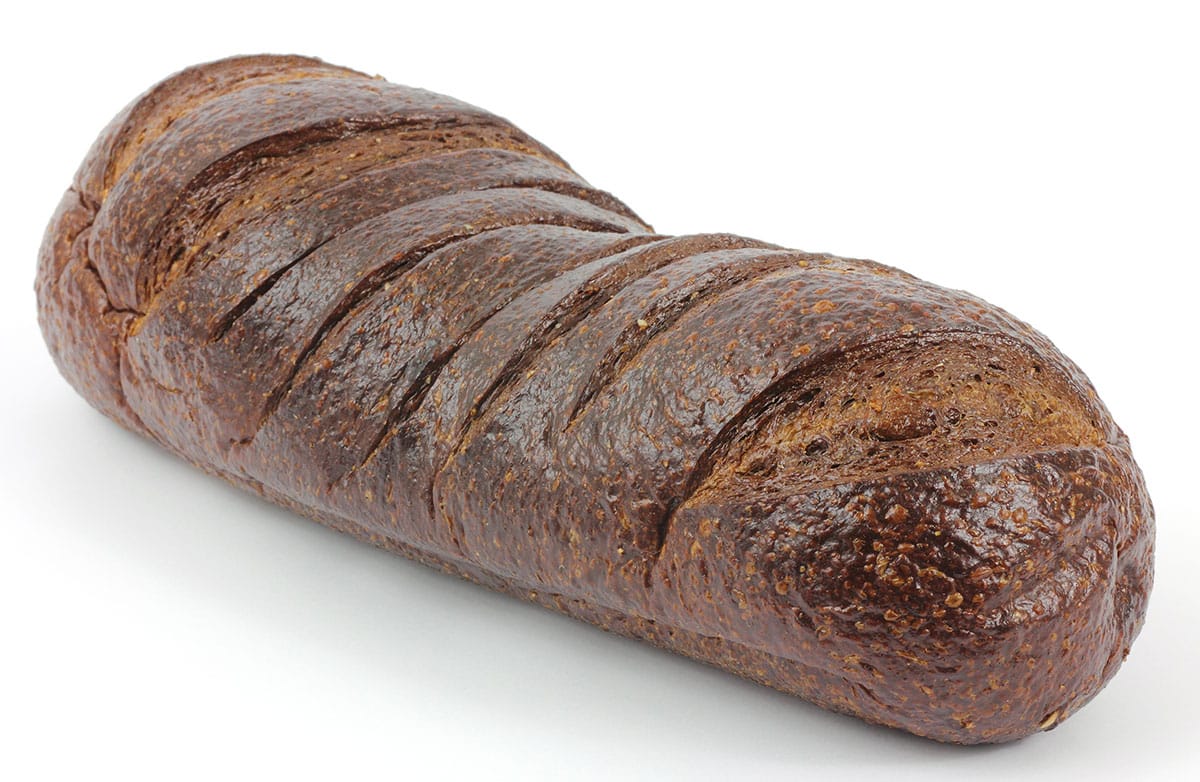
Origin of Pumpernickel: Pumpernickel bread hails from Germany and has a long history, with recorded use dating back to the Middle Ages. It is a dense, dark bread known for its hearty, earthy flavor and distinctive dark color. The word “pumpernickel” is believed to have originated from the German words “pumpern” (to fart) and “nickel” (a nickname for a devil or goblin), possibly referring to the flatulence sometimes associated with consuming this dense bread.
Pumpernickel Bread Ingredients: Pumpernickel is traditionally made from coarsely ground rye flour, water, a sourdough starter, and sometimes includes ingredients like molasses, coffee, or cocoa powder to enhance its dark color and complex flavor. The sourdough starter provides the bread with its characteristic tangy flavor and helps with leavening. The dough is mixed and fermented for an extended period, often up to 24 hours or more. It’s then baked at a low temperature for an extended period, which contributes to its dense texture and dark color.
How to Eat Pumpernickel: It is typically sliced thin and served with a variety of toppings and accompaniments. It pairs well with cured meats, cheeses, and spreads like cream cheese or mustard. It’s a popular choice for making traditional sandwiches like pastrami or corned beef, as its robust flavor complements savory fillings. Pumpernickel can also be used creatively in dishes like bread bowls for soups or as a base for canapés.
Quick Bread
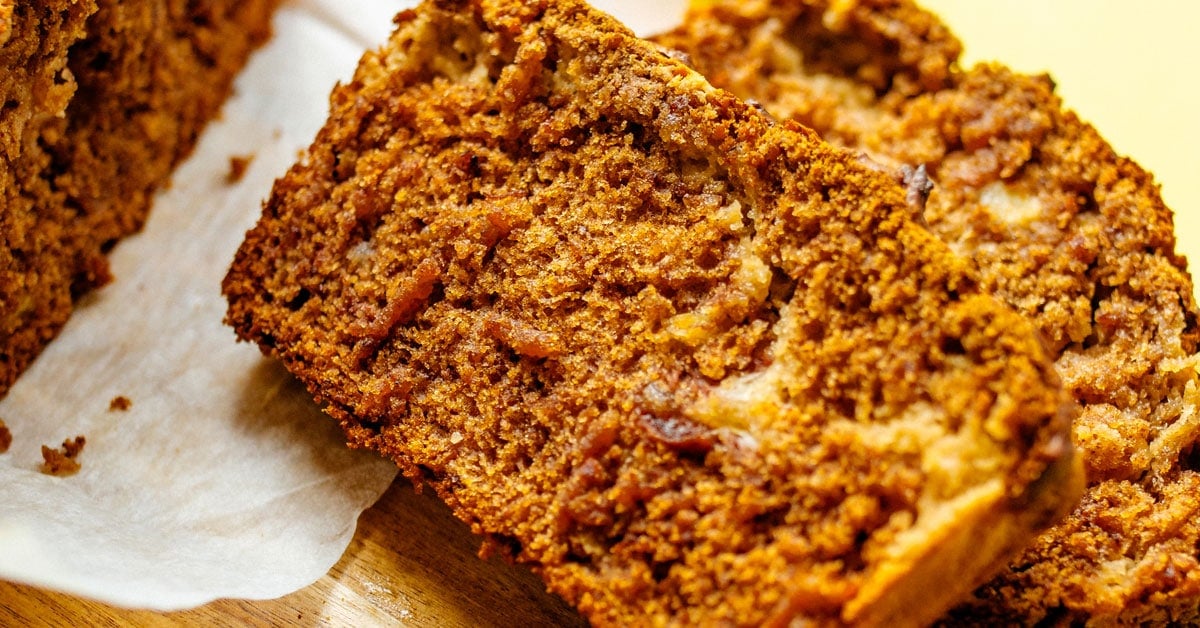
Origin of Quick Bread: Quick bread earned its name because it doesn’t require the lengthy fermentation process needed for traditional bread made with yeast. Instead, quick breads are leavened with baking powder or baking soda. This type of bread has been around for centuries, with origins dating back to early American settlers who adapted their recipes from European traditions. Quick breads encompass a wide range of baked goods, including muffins, biscuits, pancakes, crumpets, and classic loaves like banana bread and zucchini bread.
Quick Bread Ingredients: The primary ingredients in quick breads typically include flour, a leavening agent (such as baking powder or baking soda), liquid (usually milk or buttermilk), eggs, and a sweetener (like sugar or honey). Variations in ingredients and ratios lead to different textures and flavors. The leavening agents cause carbon dioxide gas to be released, resulting in a rise during baking. Quick breads are mixed quickly, often using the “muffin method,” where wet and dry ingredients are mixed separately and then combined.
How to Eat Quick Breads: They are often served as a snack, for breakfast, or for dessert. Slices of banana bread or pumpkin bread are popular choices for a quick and delicious snack, while biscuits and cornbread make excellent accompaniments to savory dishes like stews or chili.
Rye Bread
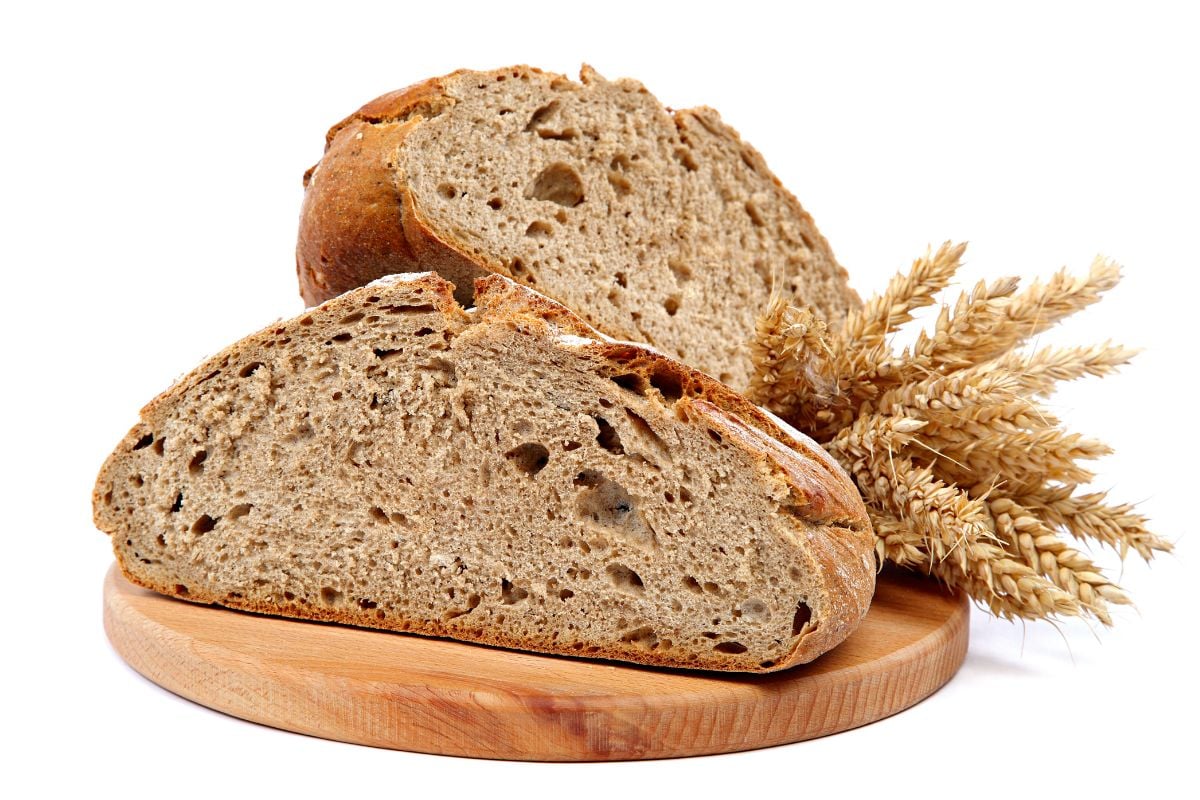
Origin of Rye Bread: Rye bread has its roots in Northern and Eastern Europe, particularly in countries like Germany, Scandinavian nations, and parts of Russia where rye grows well but wheat can be challenging. The use of rye flour gives it a distinctive flavor and denser texture compared to wheat bread.
Rye Bread Ingredients: The key ingredient in rye bread is, of course, rye flour, which can vary in coarseness. Typically, rye bread is made using a sourdough starter, which provides a tangy flavor and contributes to its leavening. The dough is mixed with water, salt, and sometimes a small amount of wheat flour. After mixing, it’s allowed to ferment, often for an extended period, which can range from several hours to several days. The dough is then shaped into loaves and baked. Rye bread comes in various forms, from dark and hearty to lighter versions, and it is known for its earthy, slightly sour taste.
How to Eat Rye Bread: It’s often sliced thinly and used for sandwiches, particularly in the classic Reuben sandwich. It pairs well with a variety of toppings, including deli meats, cheese, and pickles. Darker rye bread is a great complement to hearty soups and stews, while lighter rye bread can be enjoyed with spreads like butter, cream cheese, or smoked salmon.
Sliced Bread
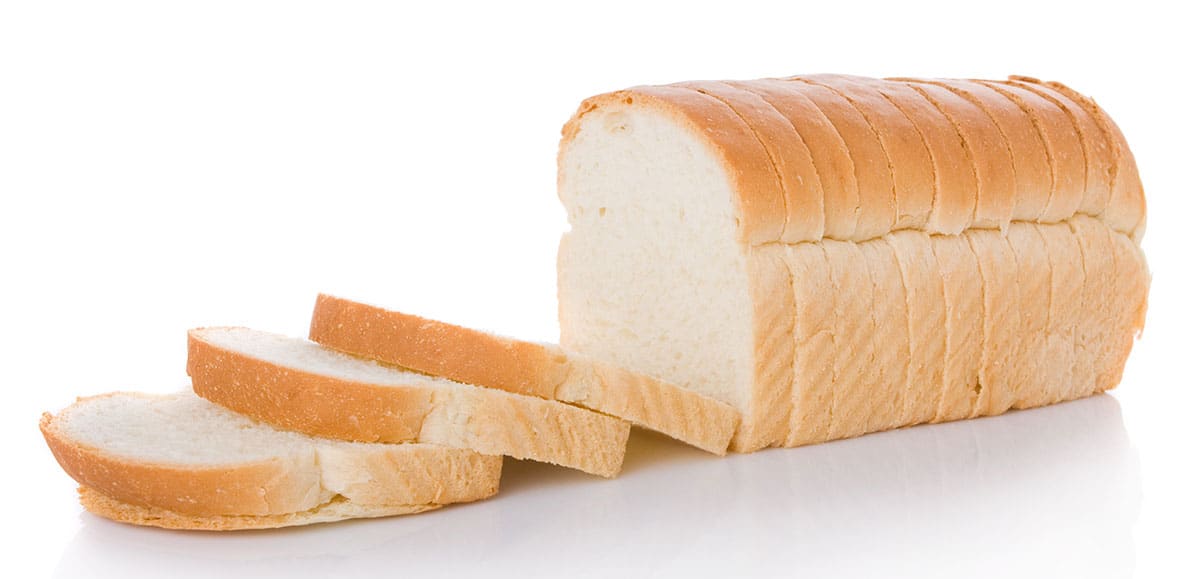
Origin of Sliced Bread: The concept of store bought sliced bread is relatively modern. Pre-sliced bread became widely popular in the 1920s when Otto Frederick Rohwedder invented the first bread-slicing machine, revolutionizing the baking industry. Before sliced bread, people had to slice bread themselves, which could be uneven and time-consuming. The introduction of sliced bread revolutionized the way people consumed and bought bread, becoming a popular staple in households around the world.
How to Eat Sliced Bread: Store bought sliced bread allows quick consistent toast, sandwiches, french toast, and a whole host of other foods we have come to love because of this consistent and convenient way of serving bread.
Sourdough Bread
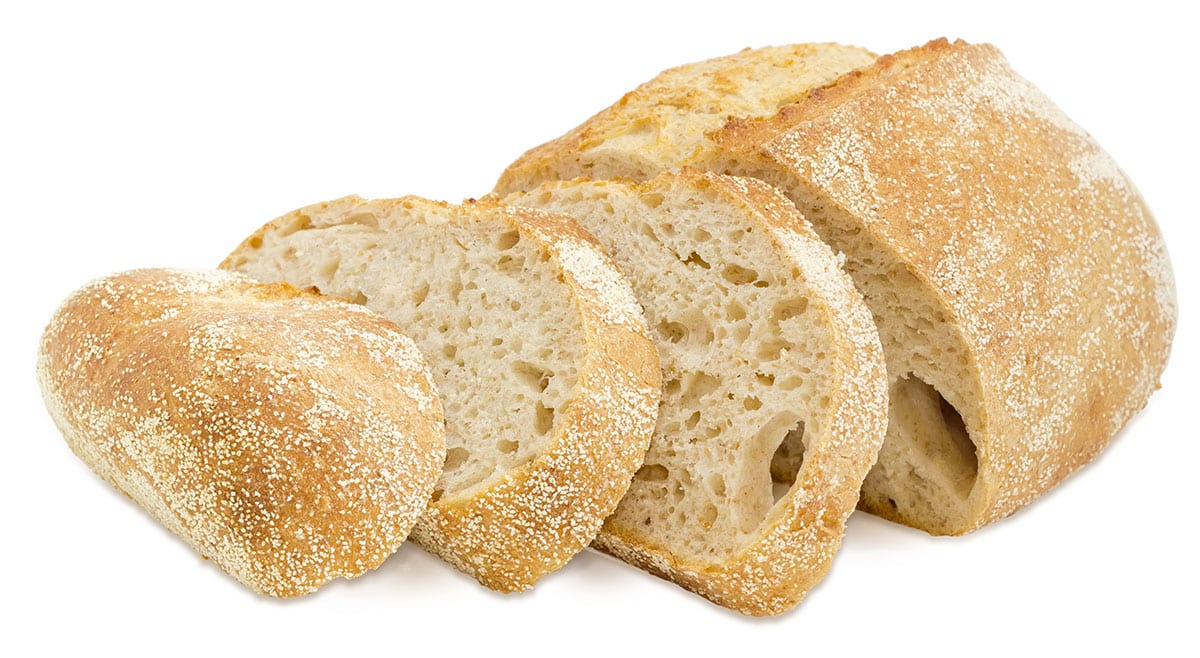
Origin of Sourdough Bread: Sourdough bread is one of the oldest types of bread, with a history dating back thousands of years. Its origins can be traced to various ancient cultures, including Egyptian and Mesopotamian. What sets sourdough apart is its unique leavening process, which relies on naturally occurring wild yeast and lactic acid bacteria, rather than commercial yeast. This natural fermentation process gives sourdough its distinct tangy flavor and chewy texture. Sourdough bread is often characterized by its thick, crusty exterior and an airy, open crumb.
Sourdough Bread Ingredients: Sourdough bread is made from just a few simple ingredients: flour, water, and salt. The magic happens during the fermentation process when wild yeast and lactic acid bacteria from the environment (your kitchen) and the flour create a natural starter culture. This starter is a mixture of flour and water that is allowed to ferment for several days to develop its characteristic flavor and leavening power. The starter is then combined with more flour, water, and salt to create the dough. After several rounds of fermentation and folding, the dough is shaped into loaves and baked in a hot oven.
How to Eat Sourdough Bread: Sourdough’s tangy flavor pairs well with both sweet and savory toppings. It’s often used for sandwiches, as toast, or as an accompaniment to soups and stews. Sourdough is also great for making artisanal grilled cheese sandwiches and bruschetta. Its crusty exterior and chewy interior make it an excellent base for various culinary creations.
Sprouted Grain Bread
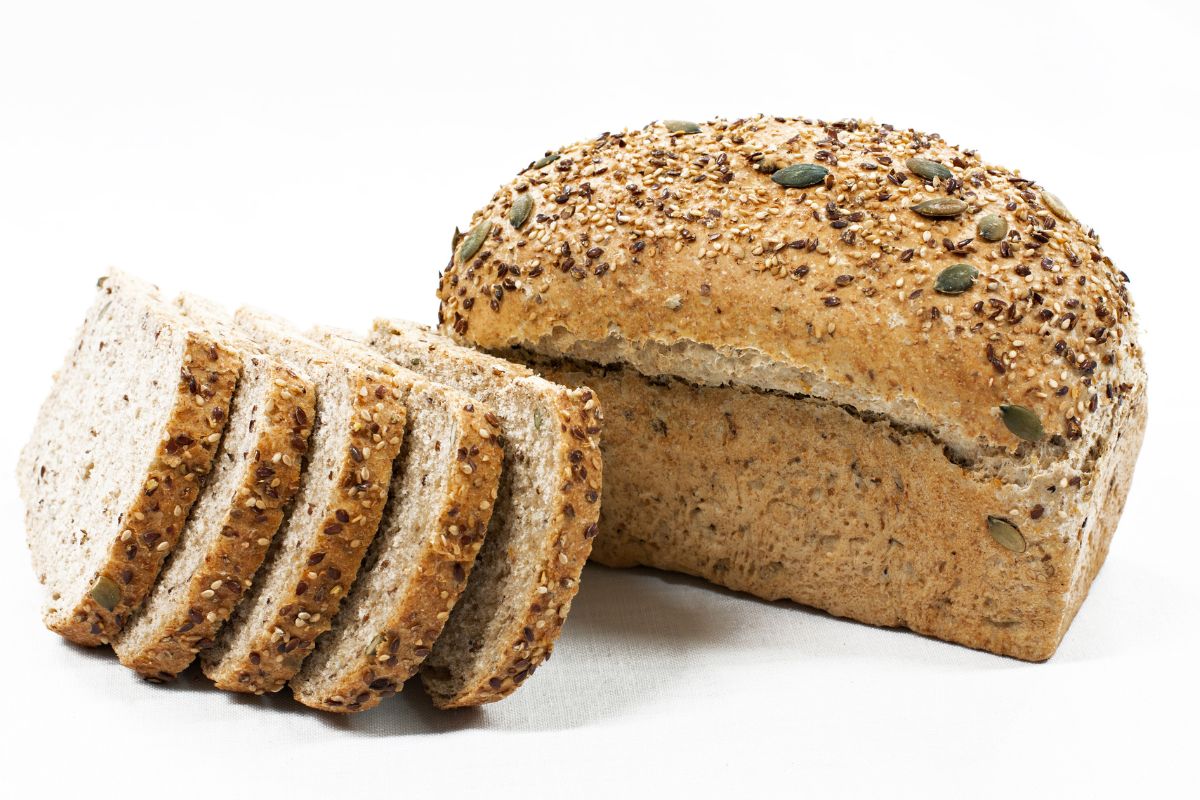
Origin of Sprouted Grain Bread: Sprouted grain bread is made from whole grains that have been allowed to germinate or sprout before being milled into flour and used for baking. This process enhances the nutritional value of the bread and makes it easier to digest. While sprouted grain bread has ancient roots, it has gained popularity in recent years due to its perceived health benefits.
Sprouted Grain Bread Ingredients: The primary ingredient in sprouted grain bread is whole grains that have undergone the sprouting process. Common grains used include wheat, barley, spelt, and millet. The process of making sprouted grain bread involves soaking the grains until they sprout, then drying and milling them into flour. The resulting flour is mixed with water, yeast, and sometimes other ingredients like honey or seeds. After kneading and rising, it’s baked to produce a hearty, nutty-flavored bread.
How to Eat Sprouted Grain Bread: This bread is eaten like any other. It is good choice for sandwiches, toast, you name it. It is often chosen by those seeking a more nutritious alternative to conventional white bread.
White Bread

Origin of White Bread: White bread is a popular and widely consumed type of bread that has been a staple in many cultures for centuries. Its history can be traced back to ancient Egypt, where the use of finely milled white flour was a symbol of prestige and wealth. White bread is characterized by its soft, tender crumb and light color, achieved by using finely sifted wheat flour that removes the bran and germ from the wheat kernel. This type of bread is leavened with commercial yeast, resulting in a milder flavor compared to sourdough. White bread gained popularity in the early 20th century with the introduction of commercial bread-slicing machines and pre-packaged sliced bread.
White Bread Ingredients: The primary ingredients in white bread include white wheat flour, water, yeast, sugar, salt, and sometimes a small amount of fat, such as butter or oil. The flour used is highly refined and lacks the fiber and nutrients found in whole wheat flour. The dough is mixed, allowed to rise, and then shaped into loaves. It’s typically baked in a conventional oven, resulting in a soft crust and a fluffy interior.
How to Eat White Bread: It’s commonly used for making sandwiches, from classic peanut butter and jelly to more elaborate deli sandwiches. White bread is also a preferred choice for making traditional French toast, as its tender crumb absorbs the custard mixture well. Additionally, it can be used for making bread crumbs and as a base for bread pudding.
Whole Wheat Bread
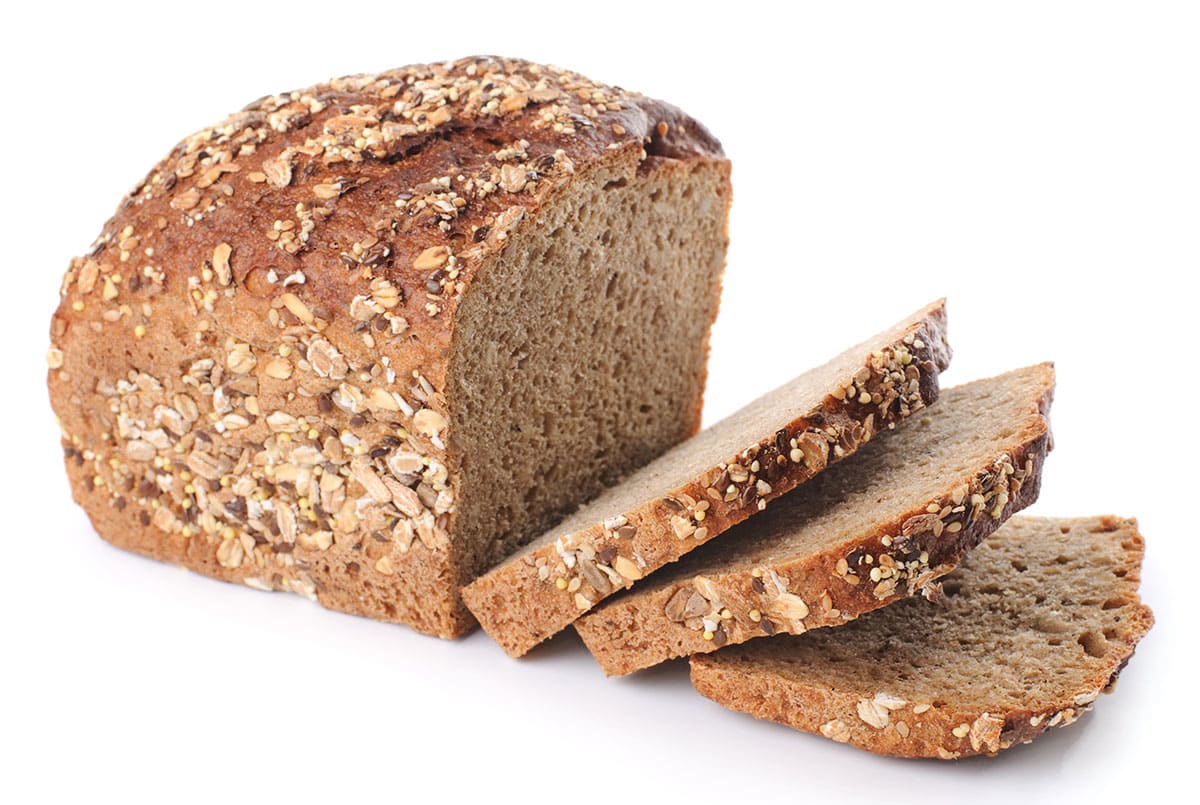
Origin of Whole Wheat Bread: Whole wheat bread is made using flour that includes the entire wheat kernel, including the bran, germ, and endosperm. This type of bread has been consumed for centuries, with origins in ancient civilizations that cultivated wheat. Whole wheat bread is known for its heartier texture and a richer, nuttier flavor compared to white bread. It is prized for its higher nutritional content due to the inclusion of the bran and germ.
Whole Wheat Bread Ingredients: The primary ingredients for whole wheat bread are whole wheat flour, water, yeast, salt, and sometimes a small amount of sugar or oil. The whole wheat flour used in this bread retains the bran and germ, which contain fiber, vitamins, and minerals. The dough is mixed and kneaded, allowing the yeast to leaven the bread. After rising, the dough is shaped into loaves and baked, resulting in a denser crumb and a darker crust compared to white bread.
How to Eat Whole Wheat Bread: This is a nutritious choice that is excellent for making sandwiches, offering a heartier texture and nuttier flavor that pairs well with a variety of fillings, from turkey and avocado to grilled vegetables. It can also be toasted and served with spreads like almond butter or avocado for a wholesome breakfast or snack. Additionally, whole wheat bread is often used to make croutons and as a base for healthy open-faced sandwiches.
Answer
Archeologist found the charred remains of flatbread baked in Jordan 14,400 years ago.
This concludes our look at types of bread. We hope you found some information on a bread type you may now want to try, or to serve in a different way. As always, happy cooking from your friends at Live Eat Learn!
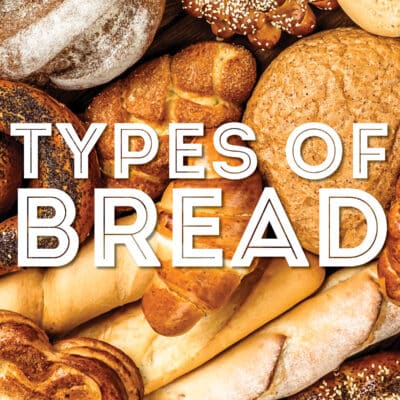
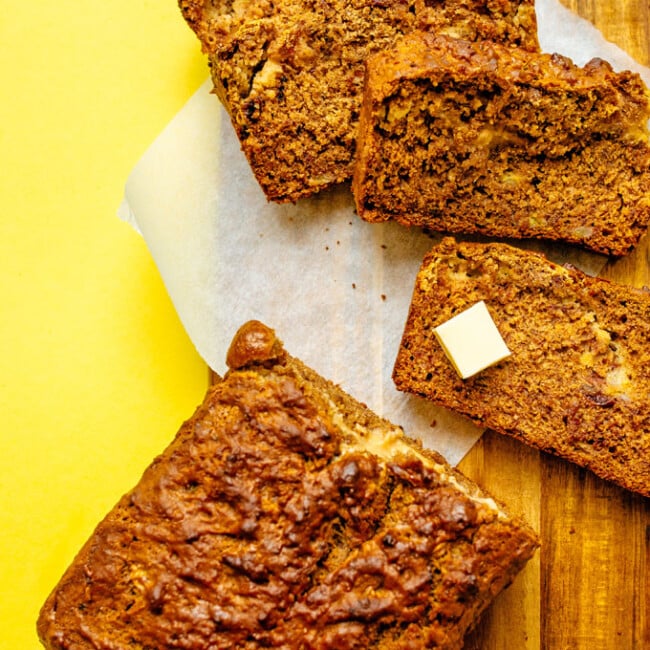
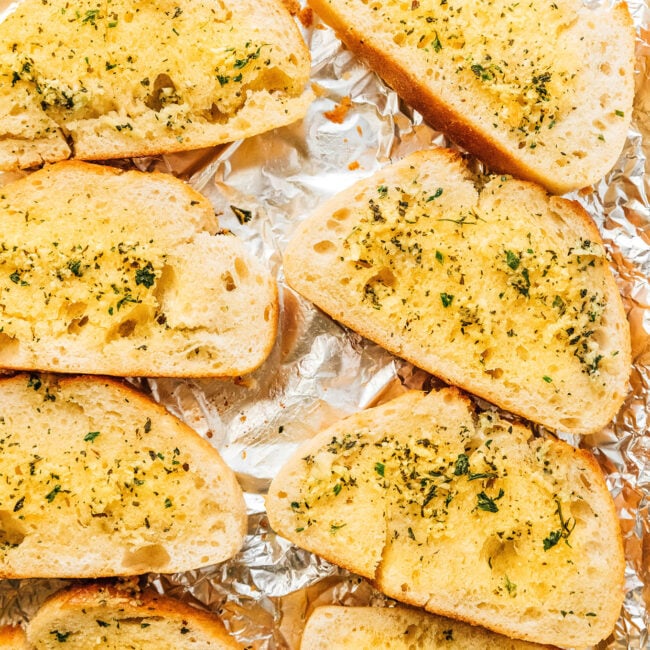
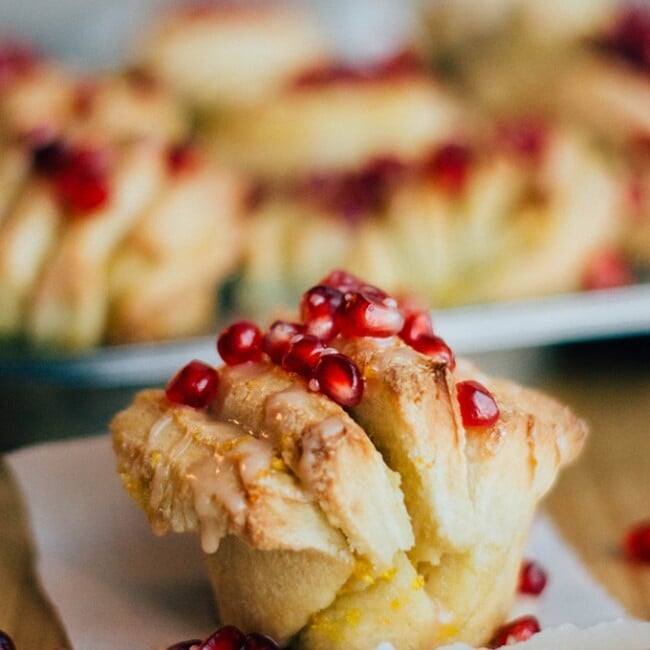
Leave a Comment